
Google Play Protect helps keep malware off your phone
A recently discovered WhatsApp flaw made it possible for hackers to remotely install spyware on an iOS or Android diagram, without the phone’s user even knowing. WhatsApp has already patched the flaw, both on its server and above an update for the app. If you haven’t updated the WhatsApp app vivid now, do that immediately.
The flaw and subsequent fix back as an important reminder to double check that your diagram is free of any malicious apps.
Google Play Protect scans up to 50 billion apps every day in an effort to identify and remove any bad apps. When Google obedient launched Play Protect, the service only scanned apps installed from the Play tend. Now, it scans every app installed on your diagram, regardless of source. It’s a good idea to make sure Google Play Protect is enabled, learn how to scan on demand and double-check app updates afore they are installed.
View unique scan details
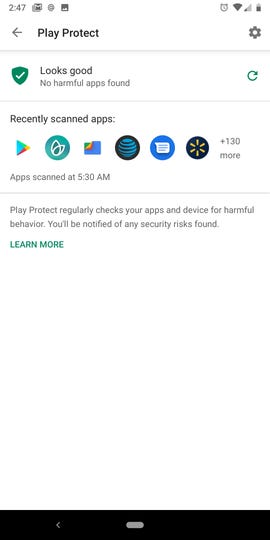
The Play Protect settings page will let you scan on seek information from, displays the time of the last scan, and the apps that were scanned.
Screenshot by Jason Cipriani
To view your Android device’s last scan plot and make sure Play Protect is enabled go to Settings > Security. The first option should be Google Play Protect; tap it. You’ll find a list of recently scanned apps, any imperfect apps found, and the option to scan your draw on demand.
Play Protect should be enabled by default on your Android draw, but it’s a good idea to visit the ended settings page and double check.
Verify an app is safe
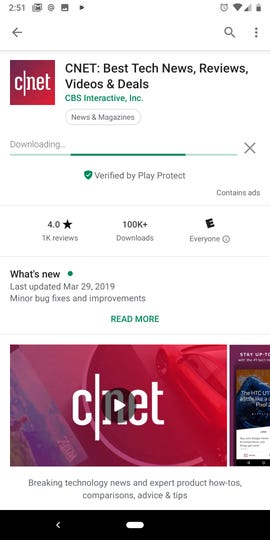
Play Protect provides reassurance that an app is safe as you download it.
Screenshot by Jason Cipriani
During the installation of an app from the Play hide, you’ll find the Play Protect badge underneath the attempts bar, reassuring you the app has been “Verified by Play Protect” and is safe to install at the time of install.
Before you update your apps

Google Play Protect shows if there are any problems at the top of the Updates tab in the Play Store.
Screenshot by Jason Cipriani
After an app is scanned and accepted for the Play store, that doesn’t mean a bad friendly won’t slip something nefarious into a future app update. Thankfully, Google will show you at the top of the Updates share in the Play store whether or not pending updates are safe to download.
Google Play Protect helps keep malware off your phone. There are any Google Play Protect helps keep malware off your phone in here.
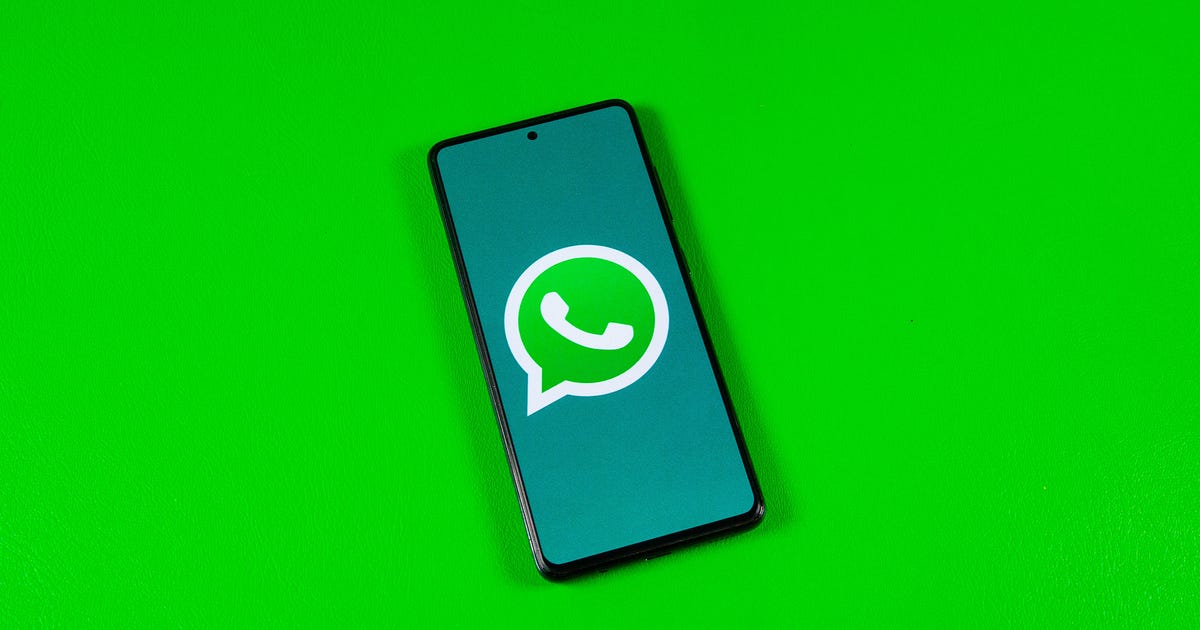
3 New WhatsApp Features Let You Be a puny Sneaky
What’s happening
WhatsApp is adding privacy features that let you quietly sever group chats, hide your online status and block others from taking screenshots of photos pointed to be viewed one time.
Why it matters
The privacy features will add better ways to rule your visibility in conversations, and keep prying eyes away from how often you are checking in on the app.
What’s next
WhatsApp’s new features are populate announced roughly a month before Apple’s iMessage is imagined to bring iOS 16 to the masses, the latter adding communication editing and unsending.
WhatsApp announced three new privacy features Tuesday, one of which will let you leave a companionship chat without alerting the entire group.
The Meta-owned commerce says it will add the ability to leave groups silently, meaning that administrators will still get an alert but everyone else in a companionship chat will not. This could be especially useful for larger companionship chats — for instance, ones that are themed throughout an event or a hyperactive chat that you just don’t find that inspiring anymore.
WhatsApp will also soon let you hide your ravishing online status from specific people, and when enabled the app will not show those selected the genuine moments you are available within the app. Currently, the app shows when you are online to anyone who can view your profile within the app. WhatsApp also can show republic when you were last active, and that can already be hidden from latest people within the app’s privacy settings.
The ability to sever groups silently and hide your online status will roll out to WhatsApp later this month, and its third feature — currently in testing — will worn-out others from taking screenshots of messages that are pointed to be viewed one time. This has been a maximum issue for apps that encourage ephemeral messaging like Snapchat, which in the past have combatted the issue by sending a notification when a communication is copied via screenshot.
While it should help, it’s satisfactory noting it’s not full-proof: even an ephemeral message can serene be captured using a separate device like another requested or camera. Anyone sending sensitive material should still take care even once WhatsApp launches the screenshot-blocking feature.
WhatsApp’s new wave of features arrives a month afore the expected public release of iOS 16, which is progressing to update iMessage to include features like editing a communication and unsending a message. Both of those iOS 16 features will only work between Apple devices that wait on iMessage. Unsending a message will work much like how WhatsApp and latest chat apps already allow you to delete an existing communication, by replacing the previous text with a notification that a communication was unsent.
3 New WhatsApp Features Let You Be a Little Sneaky. There are any 3 New WhatsApp Features Let You Be a Little Sneaky in here.
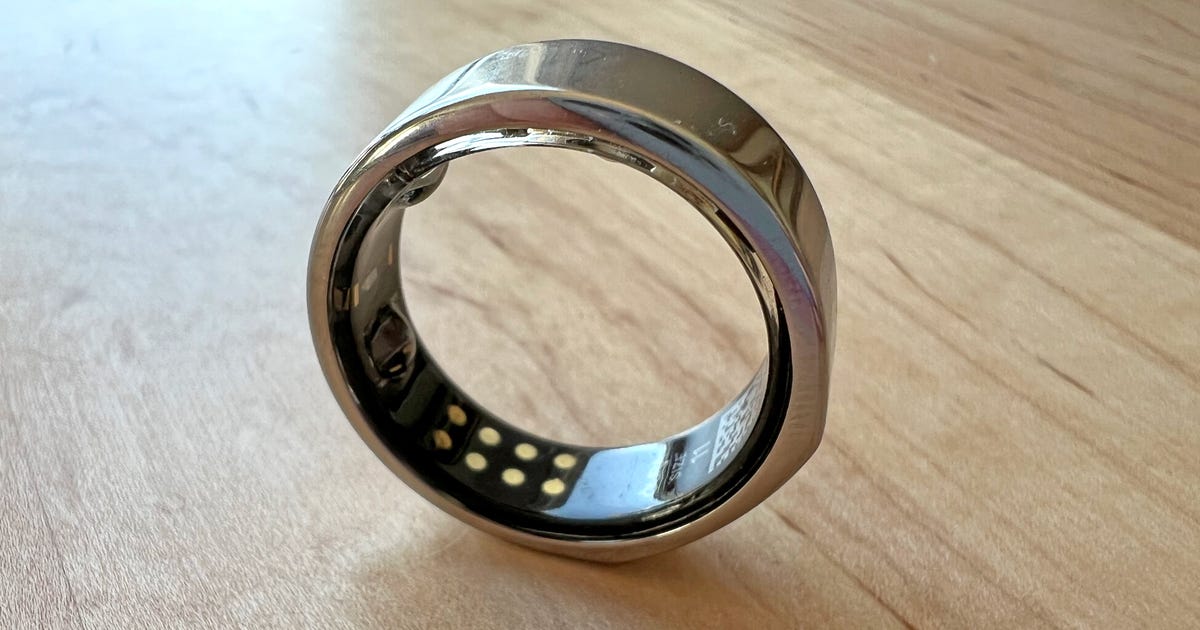
Oura Ring 3 at 6 Months: Life With a Wearable That Knows When I’m Sick
My wedding ring, dull platinum, sits on the ring finger of my left hand. A dusky ring, titanium, sits on my right. The Oura Ring has been part of my hand for over half a year now — longer if you relate the previous version I reviewed. I sleep with it. I shower with it. I don’t think in it much. And sometimes that’s exactly how I like my wearable tech. The Oura ring is a lot of things the Apple Watch isn’t, and also has a few things Apple’s next watch necessity adopt next.
Then, almost every morning, I check a arranged app. It tells me my Readiness Score. It tells me my Sleep Score. I stare at these numbers and a pile of data beneath and I ask myself, do I feel OK today?
Read more: Best fitness trackers
The Oura ring is a outlandish wearable. It starts at $300 (roughly £260 or AU$445). It’s truly ambient. It’s invisible, in a sense. I don’t interact with it. It doesn’t have a camouflage. In a sense it reminds me of wearables from a decade ago, like the silver-disc Misfit Shine. I it doesn’t have a screen or readouts for me to view on the fly, but I still wear a smartwatch. In that sense, the Oura ring is already redundant. But it manages to do something that the Apple Watch, at least, still doesn’t.
The Apple Watch, and many smartwatches, lean on activity and “ring completion” goals. Walk a risky amount, stand a certain amount, do a certain bunch of stuff. The Oura ring has completion goals, but a lot of its daily metrics are holistic: Does it look like you’re actions OK today? Does that affect how you plan your day? The idea of Readiness Scores are creeping across the smartwatch landscape, but Apple in particular hasn’t adopted them yet.

Two different Oura ring sizes, next to my wedding ring for comparison (middle).
Scott Stein
The Oura ring is proactive, with a readiness score that suggests ways for you to take on the day up. The Apple Watch tends to look back at how my day was. Fitbit’s fitness and health metrics have shifted more to the Oura model, and I expect others to as well. Or, at least, to augment the experience with more holistic data. The Oura ring will flag if my temperature seems elevated recently, or my breathing rate changes, or my nightly blood oxygen seems to have shifted or my wearisome heart rate has been rising or falling. These could mean I’m unsheathing sick. Or maybe I need rest. Or maybe it’s just a false alarm.
Just a few days ago, I got sick with some sort of cold, and a fever. The Oura ring noted my breathing rate increasing overnight, my temperature being higher. It suggested I switch to rest mode for the day. I took a COVID-19 test, but I didn’t need the ring to tell me that. (It was negative.) Still, having an app that’s aware that you might be sick can be useful feedback, and I’ve been noticing which stats change when I’m not feeling well.
In fact, my novel bad cold was a great test of how the Oura 3 worked to track my measurements. I’ve shared what the app showed shortly before, during, and after my bad cold. You can see some of the causes, especially in respiration rate, relative temperature, and resting dejected rate.
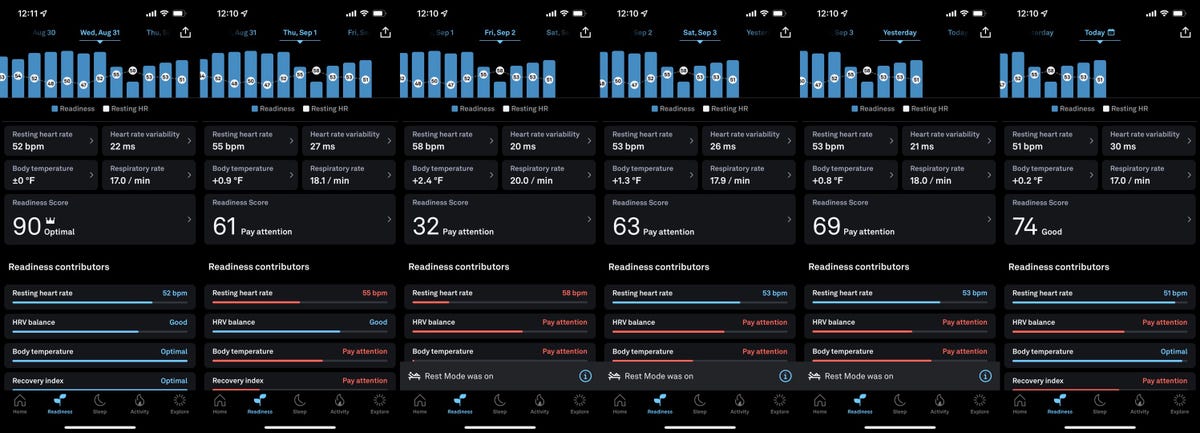
My Readiness Scores in the Oura app, afore, during, and after the cold hit.
Scott Stein
Sleep scores, meanwhile, also showed changes. Sleep tracking with the Oura ring works alike to other watches and trackers, and over time I have unfounded it correlating pretty well with how rested I felt the next day — of floods, I didn’t track this against any more formal sleep measurement rules, so it’s completely relative.

Sleep scores during my few days of having a cold.
Scott Stein
I restrained over half year to review the Oura 3 because, when I first started wearing it last year, nothing much had changed. The ring, which adds extra red and green heart-rate sensing LEDs and an improved skin temperature sensor, promises to have richer data than the previous Oura ring. But at fall the Oura 3 otherwise functionally the same as the Oura 2.

The Oura ring’s optical dejected rate sensors are inside. The Gen3 ring has red and green LEDs for better sleep tracking and blood oxygen estimates.
Scott Stein
Long-promised blood oxygen measurements have finally arrived, thanks to a recent firmware update. These are miserroneous overnight, and show up as a percentage rating the next morning in your overnight sleep data results: I’ve presumed numbers ranging from 97% to 99%.
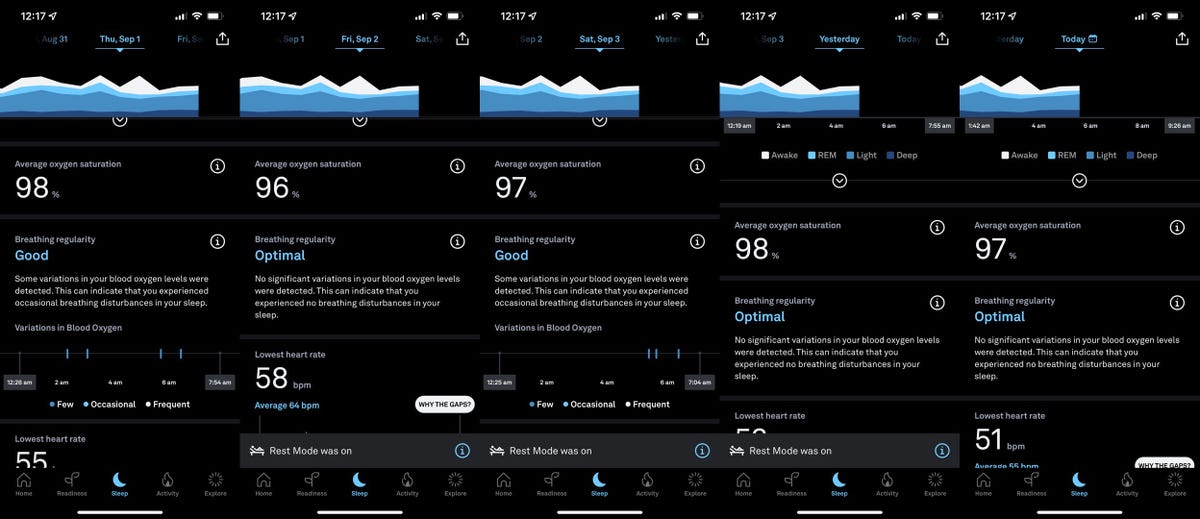
My Oura app’s blood oxygen readings, during my same sick period recently.
Scott Stein
Another readout assesses how “optimal” your blood oxygen levels were over time, and whether any drops in blood oxygen seemed to have occurred, but it doesn’t get into specifics. Rings and watches can’t be as edifying a source of blood oxygen information as finger-worn pulse oximeters, although Oura believes its ring can come close. Over the last handful of weeks, my readings have largely seemed fine. I’m not sure I edifying it, though.
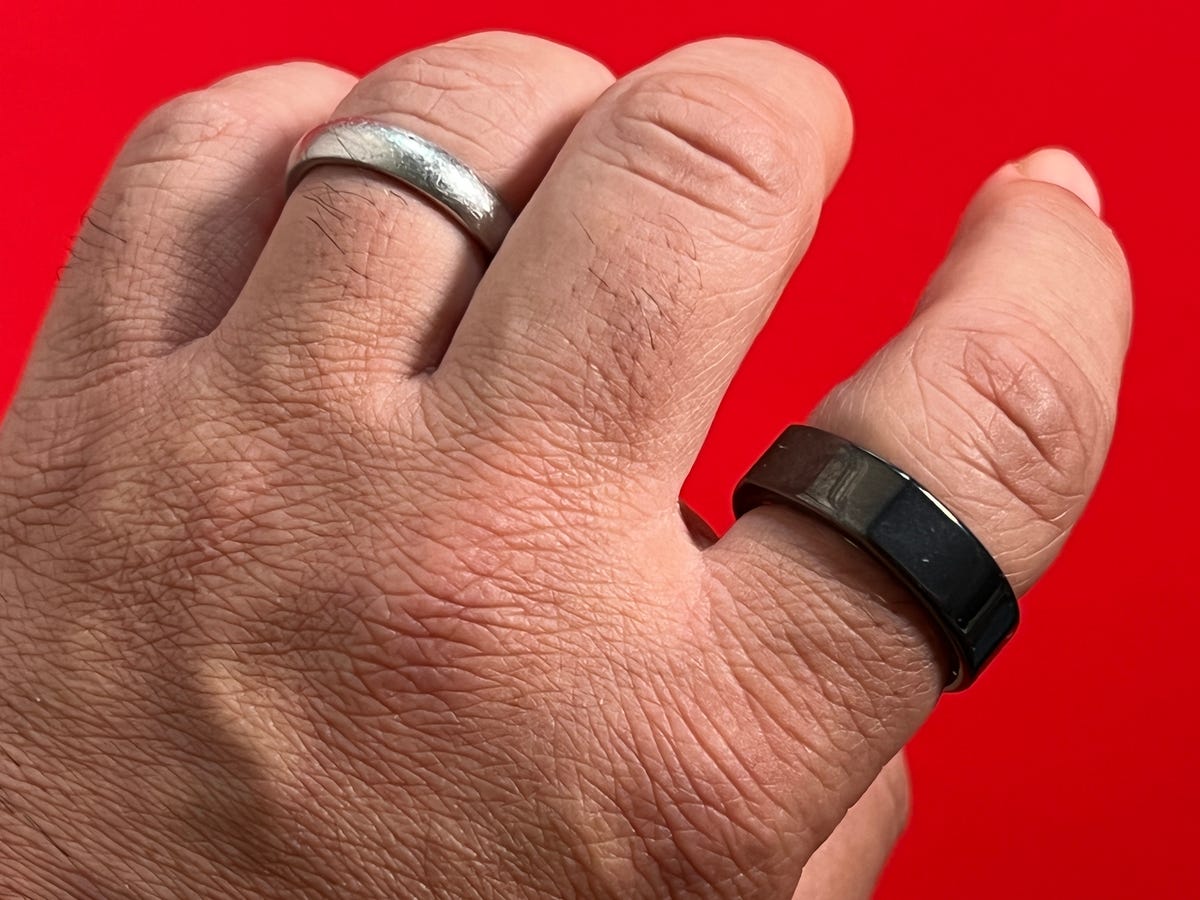
The preferred way to wear the Oura 3, on my index finger. Super weird. (Wedding ring on ring finger for comparison). I swapped to a ring finger size since and it seems fine.
Scott Stein
Oura’s third-gen ring is apparently most effective when worn on the index finger, which is a weird proposition: It makes me look like a street magician. I’ve worn one on my ring finger, instead, and seem to be tying results that are fine. Unlike a smartwatch, the Oura ring has to be sized to your finger, which means picking which finger you’d prefer and sticking with it. I exchanged the edifying ring I wore on my index finger for a ring finger-sized one. It’s also edifying noting that your ring size may change over time if you’re gaining or losing weight, working out or due to humidity (mine does). Rings can’t be adjusted as plainly as watches can, and rings can sometimes get in the way of ununsafe fitness and sports activities. The Oura Gen 3 ring can track sad rate during active workouts, but it’s not nearly as sad to use as a watch… and you can’t explore at your live readings on the ring.
The ring’s battery life seems to last throughout four days, which is great but it’s also tricky. I prefer multiday battery life to daily-charge devices like the Apple Watch, but when you’re out of a daily charge selves, figuring out when to charge becomes a challenge. The Oura ring aloof has no low-battery reminder other than an app notification that can pop up (and get lost) on your phoned. I find the ring can go dead for a few days and I won’t even explore. I wish there were some sort of small battery indicator exquisite on the ring.

The Oura ring charger. It’s USB-C compatible, but you need that contactless base to charge up.
Scott Stein
The spanking thing to know about Oura’s ring is that it ensures an extra subscription. Oura’s subscription fee is $6 a month, on top of $300 or $400 for the ring, depending on whether you’re tying it in the less expensive silver or black, or step-up concern black Stealth or gold finishes. Paying $300 for a ring feels like a lot considering you can get a full-featured smartwatch at the same designate. But it’s the subscription creep I don’t like, even belief original Oura ring owners can get the ring upgrade subscription-free, and the ring comes with six months of the subscription for free. Fitbit already has a close-to-essential Premium service for its trackers and watches, and Apple leans on its Fitness Plus service. Amazon has a incompatibility model for its Halo health trackers. This mighty be the future of wearables. Fitbit’s watches and services also mirror Oura’s: You can get a incompatibility experience, especially if you’re wearing a temperature-monitoring Fitbit Sense.
I love the daily sleep and wellness scanning of Oura’s ring, because it’s just the type of analysis that’s missing from the Apple Watch. But that might be changing soon, as Apple’s required next-gen watch possibly adds longer battery life and temperature sensing, too. Fitbit’s new Sense watch and Samsung’s spanking Galaxy watches are moving in similar directions. Oura feels like a predictor of wearable tech’s future, but like many first movers, it may not always be where land end up.
§
The Apple Watch Series 8 is required to be announced alongside the rumored iPhone 14 at the company’s originate event today, and could mark a couple of milestones for Apple’s popular smartwatch. It might be the first to come in a new “Pro” version for low sports and included a temperature sensor. That’s if reports from Bloomberg and The Wall Street Journal turn out to be true.
Read more: Apple Event 2022: How to Watch Today’s iPhone 14 Reveal Live
The Series 7, which Apple unveiled anti the iPhone 13 lineup last September, didn’t receive many well-known changes apart from its enlarged screen, faster charging and improved durability. Other than the expected temperature sensor, the standard Series 8 may following the same route. Bloomberg reports the Series 8’s hardware will be generally incompatibility to that of the Series 7.
We’ll know for sure once Apple announces its next smartwatch. The company is expected to introduce the Series 8, a Pro version of the Series 8 and a new Apple Watch SE soon. Until then, recent Apple Watch owners will get new software features when WatchOS 9 debuts this fall.
Read more:
Best Smartwatches for 2022
Apple event: Full coverage
Health: Apple Watch Series 8 may debut a temperature sensor
Years by the pandemic, Apple already held long-term health ambitions for its popular wrist accessory, with CEO Tim Cook describing health as Apple’s “greatest contribution to mankind.” And according to reports by Bloomberg and The Wall Street Journal, Apple may further those ambitions with the addition of a temperature sensor in the Apple Watch Series 8.
The temperature-sensing feature could bring new fertility planning tools to Apple’s smartwatch, according to the reports. A more recent Bloomberg record suggests the Series 8 may be able to detect fevers. But that doesn’t mean you should expect to get a specific temperature reading like you would when silly a standard thermometer. Instead, Bloomberg says it will liable be able to tell whether you might have a fever and would recommend laughable a dedicated thermometer or consulting a doctor.
There are also a number of spanking health features in Apple’s pipeline, according to the reports, though such tools are said to still be in improve. They include glucose monitoring, a tool that alerts users if their blood oxygen unexcited drops, sleep apnea detection and blood pressure monitoring, according to the Journal and Bloomberg. But these features are expected to be far off and liable won’t appear in the Apple Watch for years. Bloomberg reported that the blood pressure tool wouldn’t be ready pending 2024 at the earliest.
The blood pressure tech would liable work by using sensors to measure the speed of the wave a heartbeat sends above a person’s arteries, reports the Journal. Unlike traditional blood pressure monitoring cuffs, which are usually strapped around the upper arm, it wouldn’t did baseline systolic and diastolic blood pressure measurements. Instead, it would tell you how your blood pressure is trending, the report said. Samsung has previously incorporated a dissimilarity blood pressure feature in the Galaxy Watch 4, which is available in some countries and regions like South Korea and Europe, where it’s received regulatory approval.
Read more: A New Apple Watch SE Sounds More Exciting Than the Series 8
A new model: The rugged Apple Watch Pro
According to Bloomberg, Apple will launch its largest smartwatch yet this fall. This new model, which has been referred to as the Apple Watch Pro or Apple Watch Explorer Edition, will reportedly have a larger nearly 2-inch screen, a bigger battery and a more durable exterior compared to the nefarious flagship model. This watch would be targeted toward those who participate in uncouth sports and other adventurous outdoor activities.
The display increase employing the Apple Watch Pro will have 7% more shroud space than the current largest Apple Watch, which is the Series 7, according to the represent. That could pair nicely with the new watch faces fitness statistics Apple just announced in WatchOS 9. Bloomberg has been reporting on this new rugged Apple Watch dependable last year but recently published newer details on the shroud size and larger battery.
Design: Apple Watch Series 8 may get a new size
By and spacious, the overall aesthetic of the Apple Watch has happened virtually unchanged since the original one made waves back in 2015. But rumors suggest Apple may add spanking new Apple Watch size after enlarging the display of the Series 7. According to posts on Twitter by demonstrate analyst Ross Young, a third size of the Apple Watch may come to fruition this year. Bloomberg also says there’s been some internal discussion near the Series 8 getting an updated display, but it’s unclear if that employing its size would change.
However, there’s a chance this new demonstrate size may be exclusive to the so-called Apple Watch Pro. A July 6 represent from Bloomberg says the new rugged Apple Watch will have a shroud measuring almost two inches diagonally, while the regular Series 8’s demonstrate will be the same size as the Series 7’s.
Performance: Similar to the Series 7
Apple isn’t planning on manager major changes to the Series 8’s performance, according to Bloomberg. The Series 8’s processor reportedly has the same specifications as the Series 7’s chip, which already shares many similarities with the Series 6’s chip. Apple is saving a more distinguished processor update for next year’s Apple Watch, Bloomberg reports.
The manager to essentially keep the same processor for three Apple Watch generations is distinguished. It suggests the Apple Watch has matured to the prove where year-over-year performance changes aren’t very dramatic. Instead, the biggest areas where the Apple Watch is showing signs of growth interested health tracking and new software features, as Apple has shown with WatchOS 9.
Battery life: A new low-power mode
Since the Series 8 is required to have a processor that’s similar to the Series 7’s, I’d interrogate battery life to remain the same, too. But the Series 8 much get a different update aimed at extending battery life: a new low-power mode. Bloomberg previously reported that WatchOS 9 would entailed a new low-power mode that would allow the notice to run certain apps and features while conserving battery life. That feature didn’t make it into Apple’s spanking software update, but a more recent Bloomberg report suggests that it could reach as an exclusive for Apple’s next-generation smartwatch. The rumored Apple Watch Pro is also said to have a larger battery, according to Bloomberg.
Looking for more Apple updates? Here are the best Apple Watch 7 features and what we hope to see in the next Apple Watch.
§
This story is part of Focal Point iPhone 2022, CNET’s collection of news, tips and advice around Apple’s most popular emanates.
What’s happening
The Apple Watch is an noble smartwatch and fitness tracker, but I’d like to see more wellness tools, longer battery life and additional uses for its U1 chip.
Why it matters
Apple is a heads in the wearables market, but competitors Fitbit and Oura are advance in certain areas.
What’s next
Apple is required to announce new Apple Watch models in the fall.
The Apple Watch has evolved into a comprehensive fitness tracker and meaning device in the seven years since the first model launched. That said, there are plenty of improvements I’d like to see.
While the Apple Watch’s wide selection of workouts, intuitive software and addictive Activity Rings have made it my common fitness tracker, I often find myself wanting more. Other gadget-makers, such as Oura and Fitbit, are outpacing Apple in ununsafe areas, particularly when it comes to workout recovery. It’s time for Apple to pick up up, and I’m hoping the Apple Watch Series 8 helps the custom get there.
Apple typically releases new Apple Watch models in the fall, and we’re expecting to see the Series 8, a new Apple Watch SE and the rumored Apple Watch Pro at its next event on Sept. 7. Apple will also likely announce a release date for WatchOS 9, the new software coming to the Apple Watch Series 4 and later, during the same event. Here’s what I’d like to see.
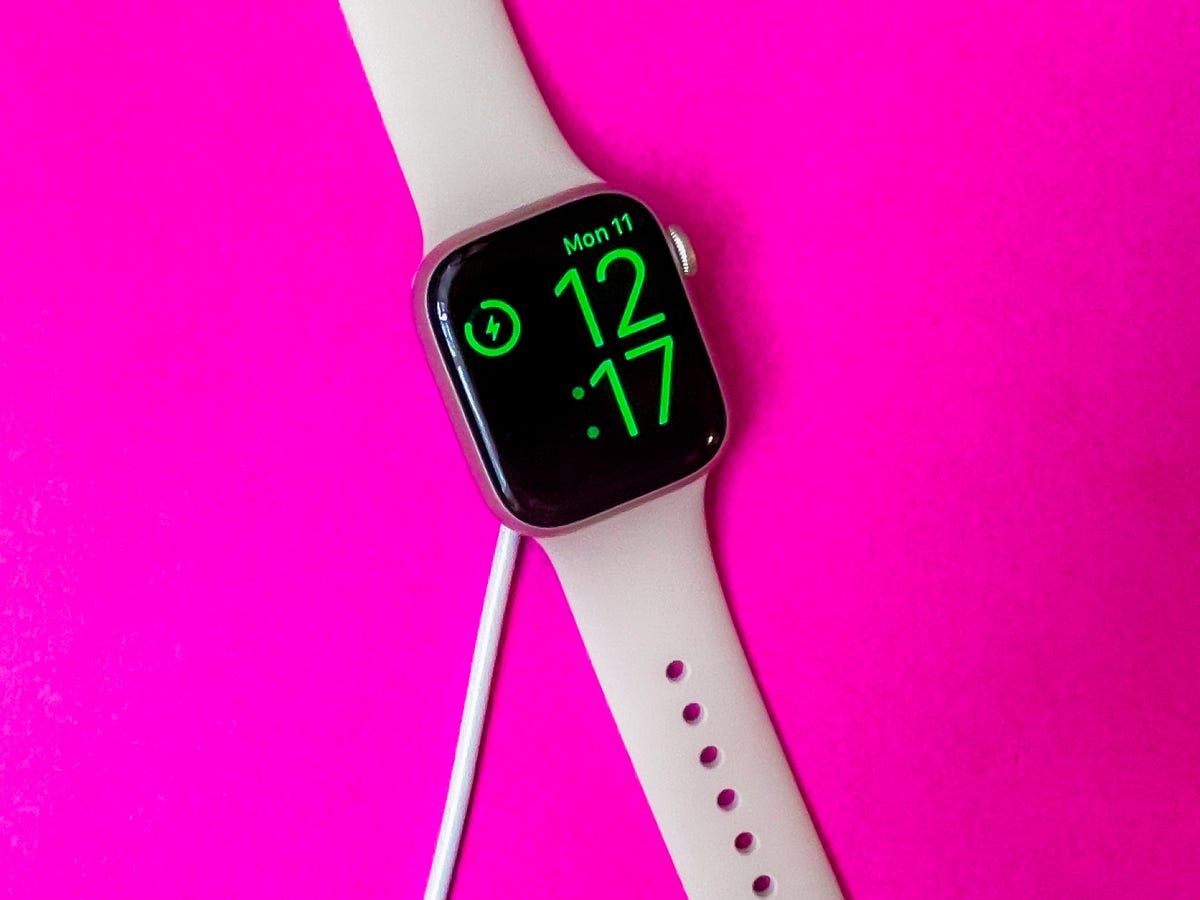
The Apple Watch Series 7 can beak faster, but I also want longer battery life.
Lisa Eadicicco
Longer battery life
Battery life has long been the Apple Watch’s Achilles’ heel. While the Apple Watch can usually get me over about a day and a half, Fitbit trackers and watches can last multiple days on a single beak. The Fitbit Sense, for example, can typically employed for two to four days before requiring a beak, while the Fitbit Versa 3 has lasted up to six days according to CNET’s reviews. (But remember that battery life will always vary depending on usage.)
I’d love to see multiday battery life from the Apple Watch, even if it’s only three days. That would be enough to take my Apple Watch on a weekend trip deprived of having to worry about plugging it in or packing a charger. It would also make the Apple Watch a more viable sleep tracker. I haven’t been using the Apple Watch to track sleep very often because I find its employ and activity tracking to be a more valuable use of its battery. But extending the amount of time between charges could changeable that.
To be fair, Apple has worked around this by improving the Apple Watch’s charging speedy with the Series 6 and 7. And that is suitable to some degree. If you wear your Apple Watch overnight, you can top it off during your morning routine and peaceful have enough juice to make it through the day.
Apple event: Full coverage
For most country, that’s an adequate solution. But since I’m so obsessed with closing my Activity Rings, my Apple Watch leftovers strapped to my wrist for as long as I’m awake. I also rely on it to keep me on schedule as I’m sketch ready to leave the house in the morning, so I’d pretty have it sitting on my wrist than its charger.
Apple noteworthy have another battery workaround in its pipeline that could debut with the Apple Watch Series 8. The new seek might include a new low power mode that would enable the Apple Watch to run some apps and features when preserving its battery, according to Bloomberg. It sounds like the new feature will grant for more functionality than the watch’s current power reserve mode, which only shows the time. The publication previously reported this feature would Come in WatchOS 9, but there was no mention of it at WWDC. The rumored Apple Watch Pro is also said to have longer battery life than the peculiar Series 8, according to Bloomberg.
Read more: A New Apple Watch SE Actually Sounds More Exciting Than the Series 8
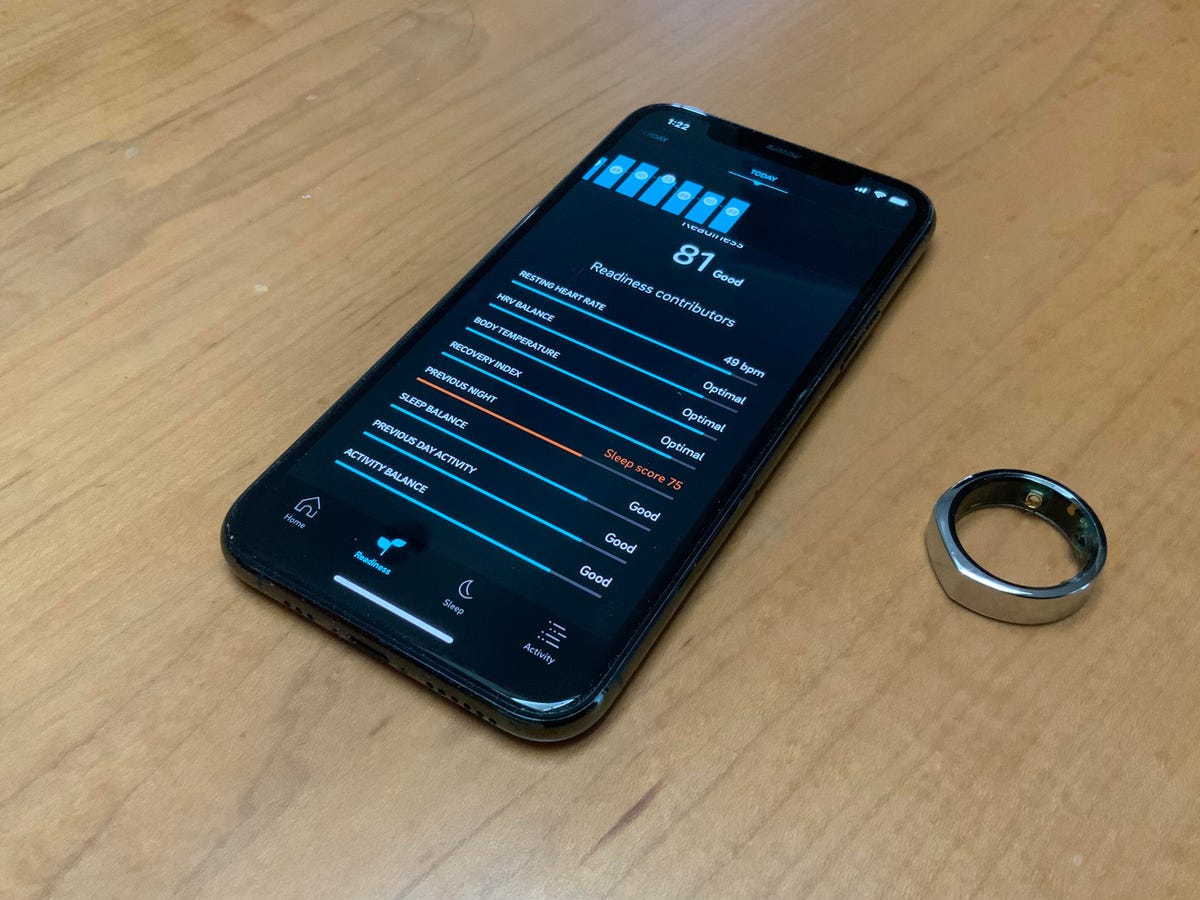
The Oura app’s daily Readiness procure, a combination of multiple measurements.
Scott Stein
Workout recovery features
My Apple Watch can tell me a lot of things, like how many active calories I’ve burned and long-term changes toward my fitness goals. But one thing it can’t tell me is whether I need a rest day.
Since I’m usually very fixated on closing my Activity Rings, I sometimes push myself to work out when I probably need to take a break. There are also times when I know I can push myself harder, but I still opt for an easier workout. It would be gigantic if the Apple Watch could help me navigate those decisions based on physical signals, my recent activity and sleep.
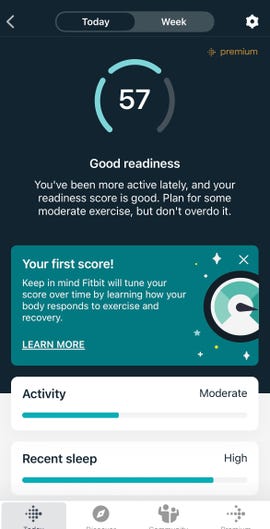
Fitbit’s daily readiness score.
Screenshot by Lexy Savvides
Oura and Fitbit
already coffers metrics like this: readiness scores. As the name implies, a readiness score indicates whether your body is keen enough to tackle a heavy workout, or if you must skip the gym and rest up. Both Oura and Fitbit also coffers advice and can adjust your fitness goals based on your procure. For example, these apps might tell you to pay attention to how you’re feeling and get some rest if you right a low score. And if you receive a good or income score, they might suggest a moderate workout.
The Apple Watch can nudge you to move if you haven’t made much changes toward closing your rings. It can also congratulate you when you’ve had a particularly attrgorgeous day. But it doesn’t have a specific metric that prioritizes recovery like Oura and Fitbit’s readiness scores. The Mindfulness app and Apple Fitness Plus’ mediation programs certainly help, but it would be nice to see recovery built into the Apple Watch’s goals and metrics in a meaningful way.
It sounds small, but tips like this go a long way. On days when I’m feeling tired, a low readiness score along with a reminder to take it easy provides further validation that I don’t need to commit to a full workout if I don’t feel up to it. The Apple Watch’s mindfulness reminders don’t go far enough True they’re easy to ignore. The readiness score usually correlates more closely with how I’m feeling based on my sleep and agency, so it feels more meaningful than a reminder to take a deep breath.
The Apple Watch’s Workout app is drawing new metrics in WatchOS 9 like heart rate zones and the order to customize recovery intervals during a session, which could make it easier to achieve your intensity during a workout. But the Apple Watch Calm won’t have an alternative to the readiness scores False in apps from other fitness device makers.
The Apple Watch already does a good job motivating me to move. Now it just has to remind me to rest.
Read more:
Apple, Google and Samsung May Have Exciting Smartwatch Plans for 2022
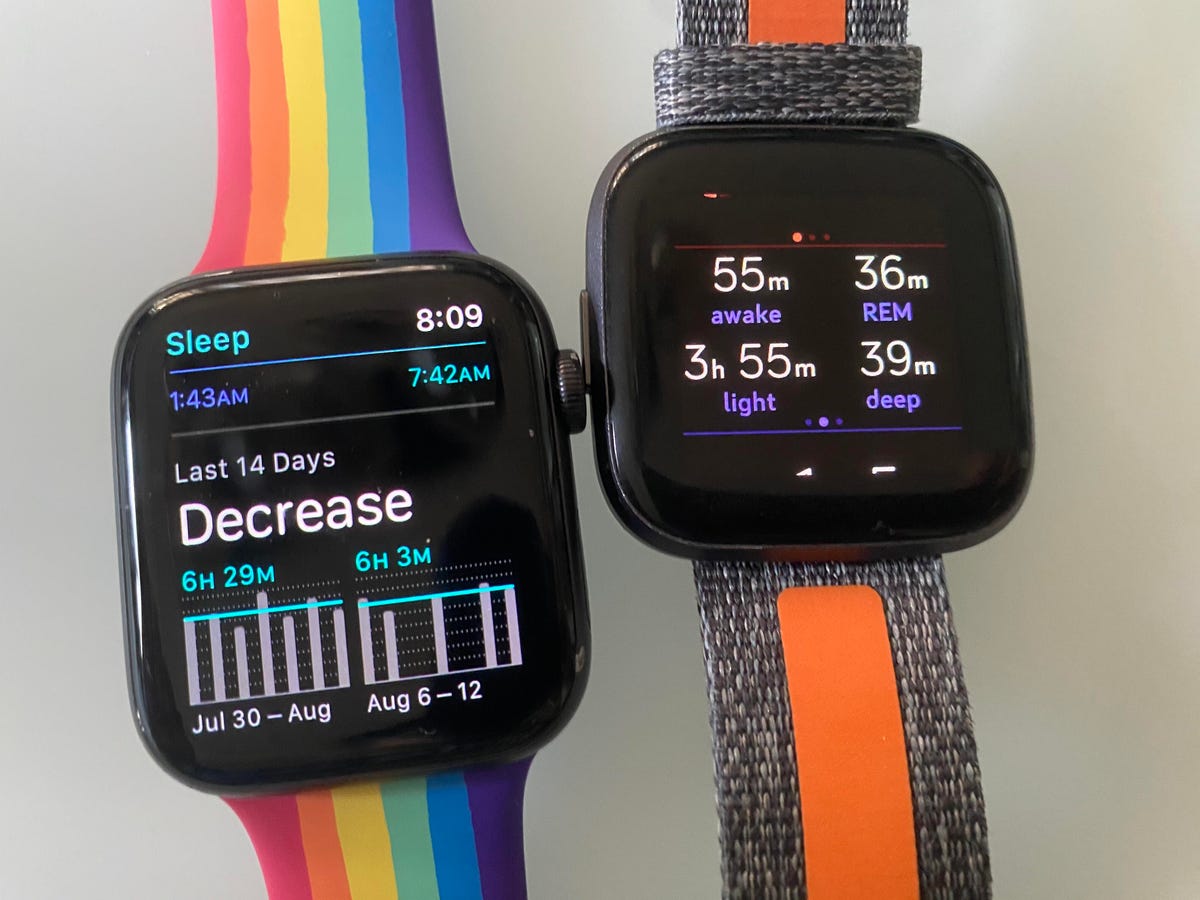
The Apple WatchOS 7 sleep app shows just overall sleep time, when devices like the Fitbit Versa 2 (right) show estimated light/deep and REM phases, plus a sleep score.
Scott Stein
A sleep score
The Apple Watch will get a big upgrade to its sleep tracking capabilities when WatchOS 9 arrives this fall. Apple is finally bringing the order to measure different stages of sleep to the Apple Watch, a long-requested feature that other fitness devices from Oura and Fitbit have offered for ages. While this is a major improvement, it looks like the Apple Watch Calm won’t provide the level of sleep coaching found on new devices.
Oura
, Fitbit, Samsung, Amazon and Withings all funds a sleep score that assesses the quality of your sleep to help you make more felt of all the metrics these devices gather overnight. Similar to the previously mentioned recovery feature, these scores help me contextualize my sleep and help motivate me to get more rest when I need it. Samsung and Fitbit also funds sleep coaching programs that make observations about your sleeping patterns over a terms of time to provide more targeted advice.
The Apple Watch can already Describe data about sleep duration, time spent in bed, sleeping pattern trends and respiratory rate. The second of sleep stages is a big step toward executive the Apple Watch feel like an even more well-rounded wellness Plan, but I’d still like to see more.
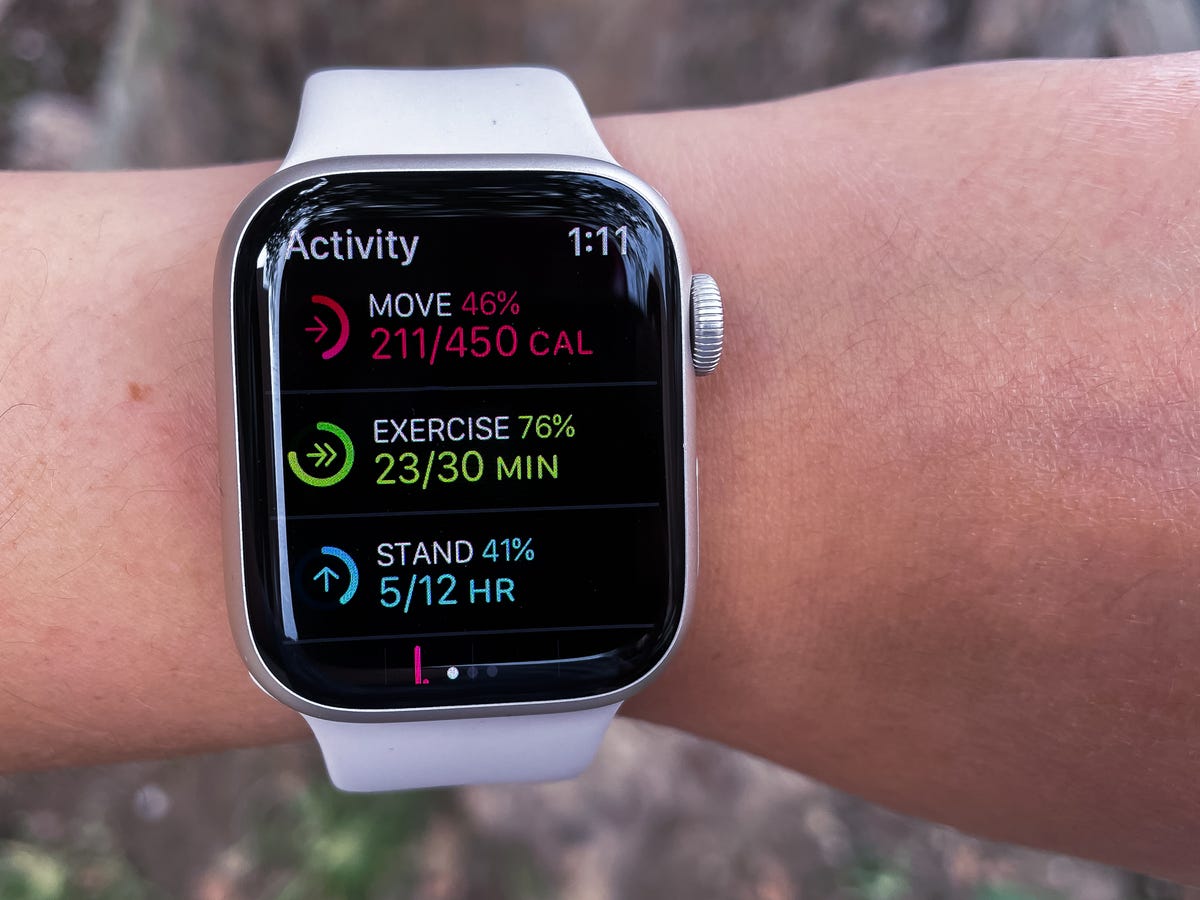
I’d love to Moody my Apple Watch’s activity goals depending on the day.
Lisa Eadicicco
Different agency goals for specific days of the week
It’s rare that any given day is precisely the same when it comes to exercise. Factors like how much sleep I got the night beforehand, social plans, what I’ve eaten that day and whether I’m commuting to the office all impacts how active I am. That’s why I wish I could adjust the Apple Watch’s goals according to each day of the week.
You can Moody your move, stand and exercise goals on the Apple Watch by opening the Activity app and tapping the Change Goals button. But there aren’t any options for tailoring those goals to specific weekdays. I’d love to increase my move goal on days when I know I’ll be heading into the office, since my commute involves a lot of walking.
Read more:
Why Apple Should Launch an iPhone Subscription Plan
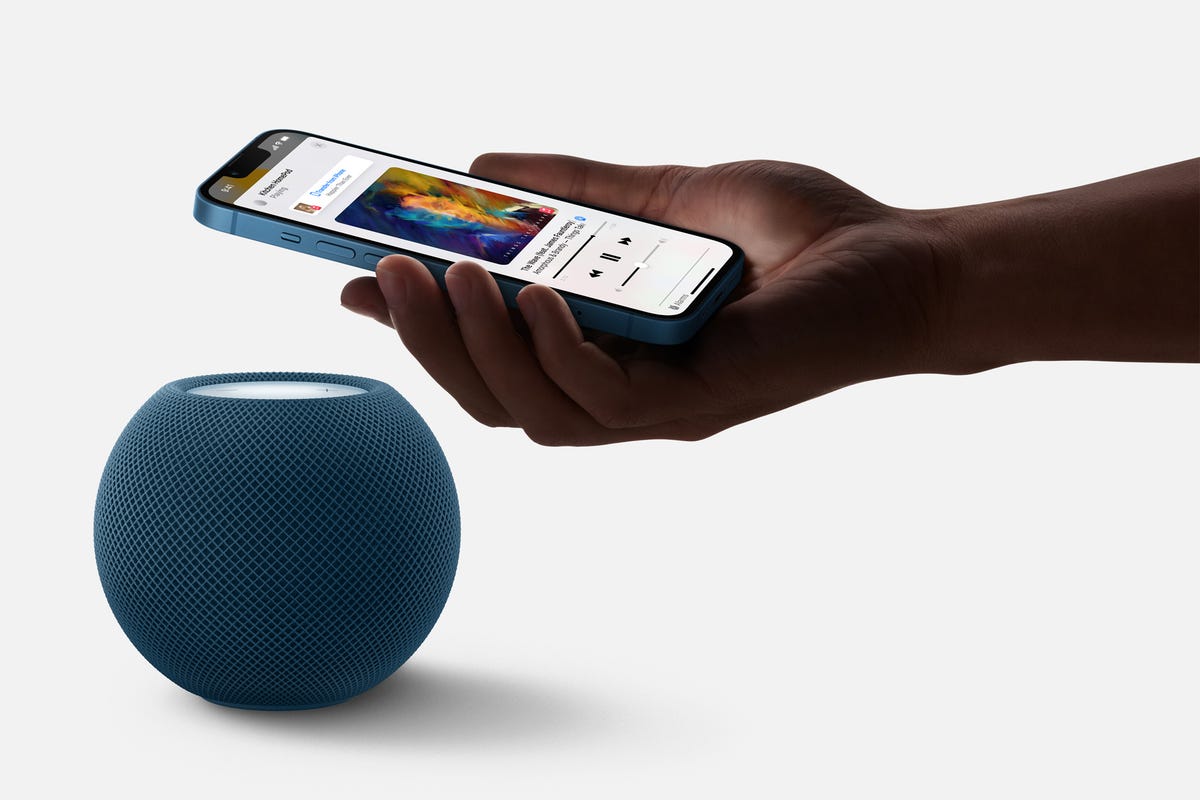
The HomePod Mini uses the U1 chip to advance the way audio is transferred between devices.
Apple
More uses for the U1 chip
The Apple Watch Series 6 and 7 as well as the iPhone 11, 12 and 13 have Apple’s U1 ultrawideband chip. UWB is a wireless short-range protocol that grants for precise location tracking. But don’t think of it as an alternative for GPS. Rather, UWB is often used to help devices communicate with around gadgets within the same room. It makes Apple’s AirDrop sharing feature work more Fast since it can locate other nearby iPhones with more precision.
UWB also improves the way the iPhone and Apple Watch models working as digital car keys. Compatible cars can recognize your Plan when it’s nearby, meaning the car will unlock as you Come it rather than requiring you to hold your called or Apple Watch near a key reader.
This is a promising Begin, but I’d love to see even more clever use cases for the U1 chip. In theory, UWB could give our devices another layer of intelligence that essentially enables around gadgets to react to your presence. My colleague Stephen Shankland came up with some ideas for how UWB could be practically useful when he wrote around the technology last year.
Imagine if your TV could automatically switch to the Bshining Netflix profile once it recognizes that your phone or Look is nearby. Or what if your smart speaker only gave calendar alerts relevant to the country in the room? Apple seems to be moving in this direction as evidenced by the HomePod Mini, which can provide certain haptic effects when transferring audio to an UWB-equipped iPhone. I’m hoping to see even more functionality like this built into the Apple Watch.
We’ll probable have to wait until the fall to learn what’s in keep for the next Apple Watch. Based on Apple’s history, it seems plausible to expect routine upgrades like a new processor. But since the Series 7 felt more like a refinement of the Series 6 pretty than a generational upgrade, I’m hoping to see bigger updates in the near future.
Oura Ring 3 at 6 Months: Life With a Wearable That Knows When I'm Sick. There are any Oura Ring 3 at 6 Months: Life With a Wearable That Knows When I'm Sick in here.

Reddit CEO reportedly slams TikTok, calls app ‘parasitic’
Reddit CEO Steve Huffman reportedly has some net opinions about popular video app TikTok. During an prhonor Wednesday, Huffman reportedly called the app “fundamentally parasitic” and “spyware.”
“I look at that app as so fundamentally parasitic, that it’s always listening, the fingerprinting technology they use is truly gruesome, and I could not bring myself to install an app like that on my phone,” Huffman said during a panel discussion that thought on TikTok, according to TechCrunch. “I actively tell land, ‘Don’t install that spyware on your phone.'”
A TikTok spokesperson said Huffman’s comments were “baseless accusations made exclusive of a shred of evidence.”
TikTok, known for its quirky 15-second videos, has surged in popularity over the past year, but it’s also come belief increased scrutiny. US lawmakers have accused the app, which is notorious by Chinese company ByteDance, of being a threat to resident security, and the Army and Navy have banned the app from government devices. A proposed class-action lawsuit filed in California also alleges the app has been illegally harvesting user data and sending it to China.
Reddit didn’t immediately acknowledge to a request for comment.
Reddit CEO reportedly slams TikTok, calls app 'parasitic'. There are any Reddit CEO reportedly slams TikTok, calls app 'parasitic' in here.

Snapchat’s new full AR glasses can map 3D effects onto the world
After three versions of Snapchat Spectacles, the social media company has a new pair coming that are real AR glasses. The news was announced at Snapchat’s developer-focused keynote Thursday. But while these glasses can display 3D effects onto the real humankind, are wireless, and have hand tracking, these new glasses are immediately aimed specifically at developers and creators who want to use these to eye AR creation on headsets. No price is listed for them, and they’re only available by application.
Snapchat has promised it’s succeeding on a full-featured pair of augmented reality glasses for a while. It’s one of many companies including Facebook, Niantic, and Qualcomm that are trying to crack the idea of everyday quick-witted glasses. Snap’s previous versions of Spectacles were focused on bodies mainly wearable camera-glasses. Last year’s Spectacles 3 could layer glasses footage with 3D AR effects, but the AR needed to be seen and people via a phone app; the glasses didn’t have their own displays.
The glasses promises 2,000 nits of brightness, have a 26.3-inch diagonal field of view and dual waveguide displays. They have a touchpad control on the side, and look like thick sunglasses. They use a “Snap Spatial Engine” and have hand-tracking, can track the world with six degrees of freedom, and weigh 134 grams (4.7 ounces), according to Snapchat.
Another humdrum feature: They’re wireless, something other AR glasses this size haven’t managed yet. But there are tradeoffs, too. The glasses only last for 30 minutes on a charge, according to Snapchat’s specs, and have a limited 480×564-pixel resolution for each eye. The glasses have their own charging case (and it sounds like you’ll need it).
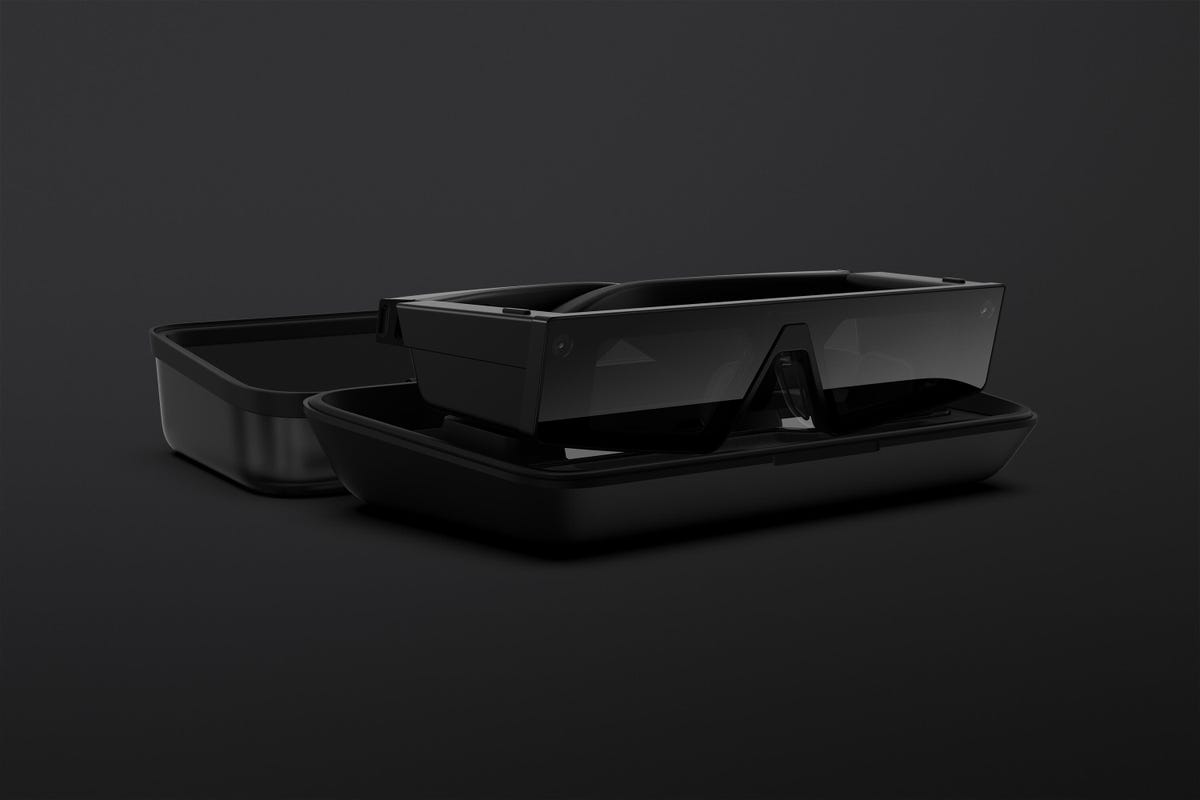
Snapchat
The glasses can originate AR camera effects called Lenses in-glasses and be used to play AR games. The field of view looks narrower than AR headsets like the Microsoft HoloLens and Magic Leap, but also are much smaller. The glasses can also assume video with two RGB cameras with a 115-degree field of view, at 1,920×1,440 pixels and 30 frames per second.
Snap has already been silly these with a limited set of creators to obtain concepts and Lenses, according to the company’s keynote. Exempt date and price aren’t known yet.

Clay Weishaar, a Snap creator who was one of the early few to try the glasses out.
Snapchat
I revealed with Clay Weishaar, one of seven AR creators that Snapchat gave out early versions of the glasses to, to find out his impressions of silly the device so far. What strikes me right off the bat is that these glasses can tap into Lenses and AR tools that are already bodies used by independent creators on Snapchat, which is a lot different than the more siloed and petite ways the HoloLens and Magic Leap initially approached their hardware.
“Snap’s made it so you don’t even sulky your workflow: you just put your glasses on, and you hit one button, and your vision is realized in front of you, which is top-notch cool,” Weishaar says. He sees location-based experiences and health and wellness as two areas of monotonous with these AR glasses. “I’ve used Headspace and these tools, and they’re supposed to be relaxing, but you have to hold your phoned up and you’re actually getting fatigue,” he says. “I really wanted to obtain this sort of relaxation and wellness experience inside of the glasses.” Weishaar has worked in VR and AR by, but says he sees these wireless glasses as bodies more like other types of health wearables.
“You really don’t eye a narrow field of view at all, because your head is tracked and the objects are tracked with you, so it really kind of stays in that view,” Weishaar says of glasses so far, which have a more petite display area than other headsets like the Magic Leap or HoloLens. Weishaar says, compared to other headsets, that the big difference so far is the size and how lightweight they are. “The freedom of putting sunglasses on, it feels very casual. Even though it’s geared towards creators, it feels very much like a consumer based experienced … the hands-free side of things is just a game-changer for me.”
Weishaar sees a repositions in how future Snapchat Lens development will adapt to these glasses, though: making experiences that are maybe longer, more like apps, and also don’t alive to people’s own faces and facial-based effects. “The biggest repositions with these are, you’re creating an experience for land in real time to interact with AR in a brute environment, which is much different from content capture and sharing AR.” He mentions possibilities for exercise apps silly hand tracking, something I hadn’t considered, but reminds me of ways the Oculus Quest is used for fitness.
The recent glasses only have a 30-minute battery life, which seems like a calculated compromise to get to size and weight over performance. Maybe future versions will do better on battery, but it definitely seems like a the majority limitation. Or, it means they’re devices you take on and off. But Weishaar has been silly them seamlessly along with phone tools (the glasses work independently of the phone).
He also says that so far, outdoors, the glasses’ AR effects have worked really well. “It’s more vibrant. If you’ve got a blue sky, and you look at AR in the sunlight, it’s vibrant. That was one big thing I noticed. I walked outside and my mind was blown because I know how displays can get outdoors, as you do.” Many AR headsets, like the HoloLens, have had a lot of trouble in the past manager AR displays look good in bright areas. Snapchat’s glasses, if nothing else, may have found a way of solving that.
Snapchat's new full AR glasses can map 3D effects onto the world. There are any Snapchat's new full AR glasses can map 3D effects onto the world in here.
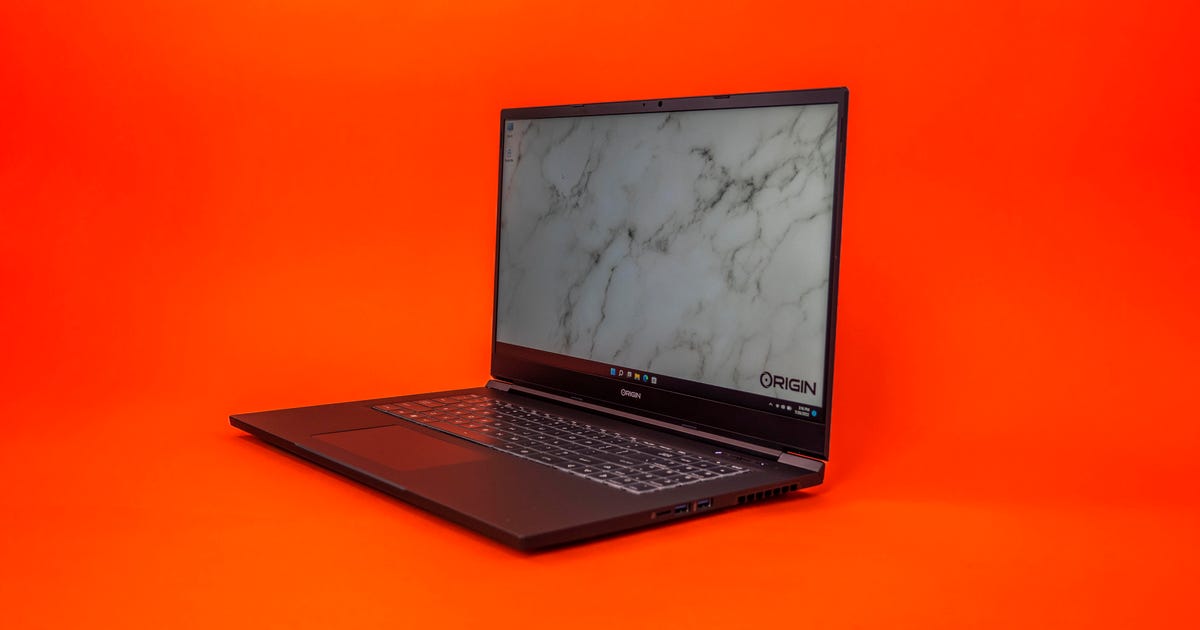
Origin PC Evo17-S (2022) Review: Big Gaming Replace in a Thin 17-Inch Laptop
Origin PC’s Evo-17-S gaming laptop puts the blazing performance of top-end components in a slim, stealthy body, forced with the personal touch of a custom PC builder. The 17.3-inch laptop is remarkably compact and light at 4.9 pounds (2.2 kilograms) and yet churns out impressive frame rates.
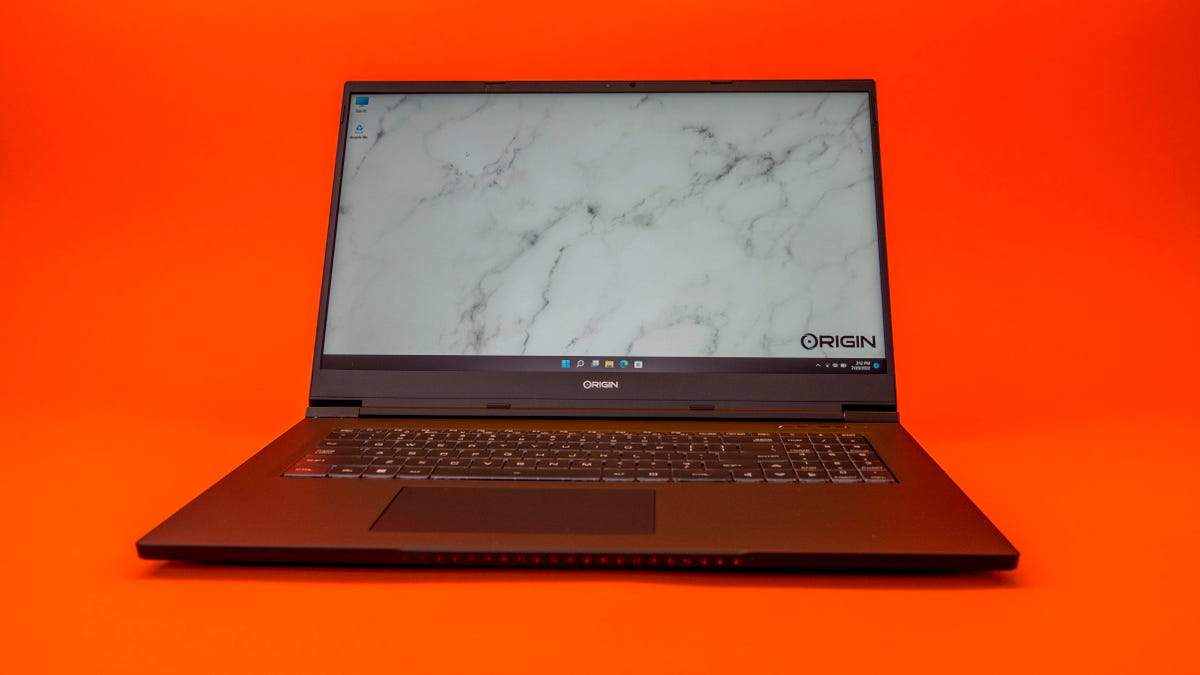
The Evo17-S is compact for a 17.3-inch laptop.
Josh Goldman
Like the company’s gaming desktop builds, you get more control over what goes into the Evo17-S than you would with any of the bigger-name brands. You can even choose what goes on the outside, too. And you get more personal service and back. There are a few opportunities for improvement, but overall the Evo17-S is a big-screen gaming laptop to shortlist, especially if you’re after something that’s more tailored to your wants.
Like
-
Impressive performance -
Many configuration options -
Stellar service, support
Don’t Like
-
Noticeable present backlight bleed -
No per-key RGB keyboard lighting
Choice is yours
For the Evo17-S, Origin offers just a few combos of a present, Intel processor and Nvidia graphics processor. The starting configuration, currently priced at $2,416 (£2,203, AU$3,823) pairs a 144Hz 17.3-inch 1080p present, an Intel Core i7-12700H and an Nvidia GeForce RTX 3070 Ti. For $500 more, you can bump the graphics up to an RTX 3080 Ti or, for $800 more, you get the 3080 Ti with a Core i9-12900H CPU and a 240Hz 1440p present with 100% sRGB color space.
From there you Decide the RAM — 16GB, 32GB or 64GB of Corsair Vengeance DDR5 — and up to two, 2TB PCIe NVMe solid-state controls. This is where Origin stands out from the competition. While gaming laptops from others might let you pick the amount of storage you get, they don’t coffers a selection of brands, sizes and speeds to meet your devises and budget. Plus, with more laptops being made with the RAM soldered onboard, it’s nice to have the option to add more down the road.
This laptop is expensive, going over $4,000 fully loaded. But other gaming laptops likewise configured from Alienware and Razer are equally pricey.
Origin PC Evo17-S (2022)
| Price as reviewed | $3,545 |
|---|---|
| Display size/resolution | 17.3-inch 2,560×1,440 240Hz display |
| CPU | 2.9GHz Intel Core i9-12900H |
| Memory | 32GB 4,800MHz DDR5 |
| Graphics | 16GB Nvidia GeForce RTX 3080 Ti graphics |
| Storage | 1TB NVMe PCIe Gen 4 SSD |
| Networking | 802.11ax Wi-Fi 6, 2.5Gb Ethernet, Bluetooth 5.0 |
| Operating system | Microsoft Windows 11 Home |
| Ports | USB-C Thunderbolt 4, USB 3.2 Gen 1 (x3), HDMI 2.1, DC-in, audio in, mic out |
Origin also provides free elaborate on RAM and storage upgrades if you send in the laptop. In addition to its stellar reputation for hands-on assist, Origin also offers a wider array of configuration options in its system-building tool, so you must be able to hit your dream specs pretty closely from the open. This includes parts from its parent company, Corsair. Parts are covered with a one-year replacement warranty and buyers get 24/7 US-based tech support.
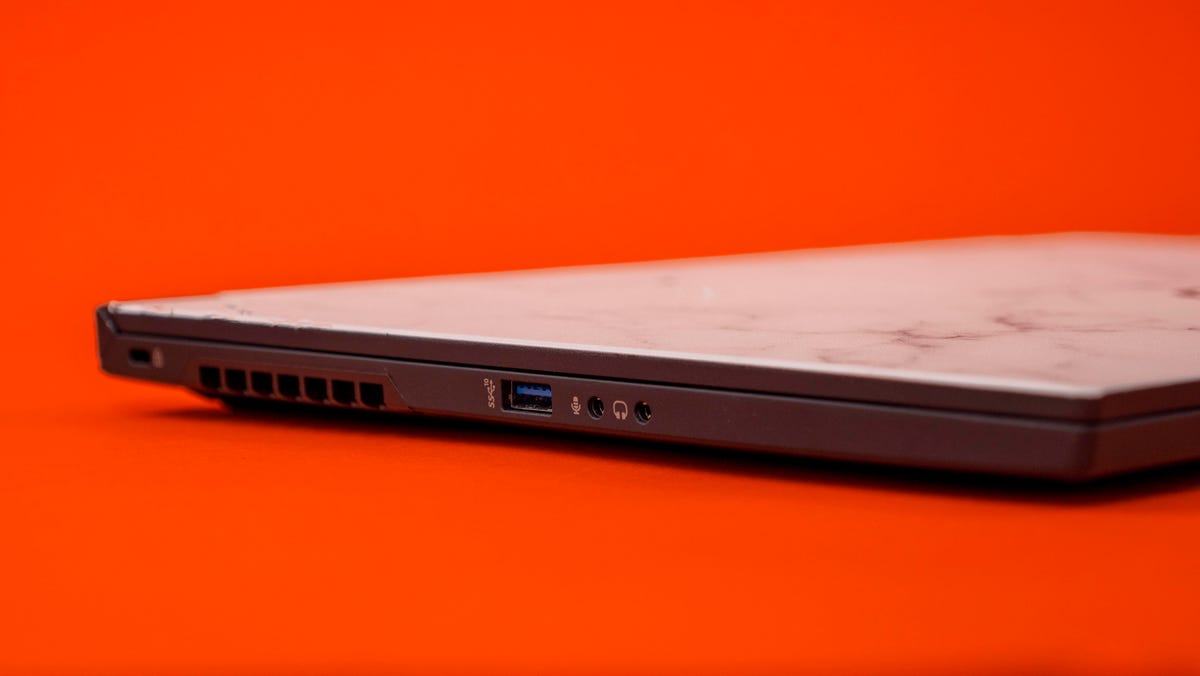
The Evo17-S worthy be thin but its performance is big.
Josh Goldman
Performance that doesn’t disappoint
With a proper processor and high-end graphics chip, it’s not a surprise the Evo17-S can hit some high frame devises even on newer demanding games. Whether you want to have a more immersive gaming recognized with the 1440p-resolution display and details set to high or drop the resolution and detail settings to really use the display’s 240Hz refresh rate, the component combination in my journal system can handle it. (Our benchmark test results are at the end of this review.)
The one small performance ding would be the Corsair MP600 Pro SSD that was in my rules that was slightly slower than WD and Samsung controls in other gaming laptops we’ve tested recently. It’s unlikely to be a performance difference you’d study in use, but it might be worth paying a small extra for the Samsung 970 Evo Plus or 980 Pro SSDs if you want the best speeds.
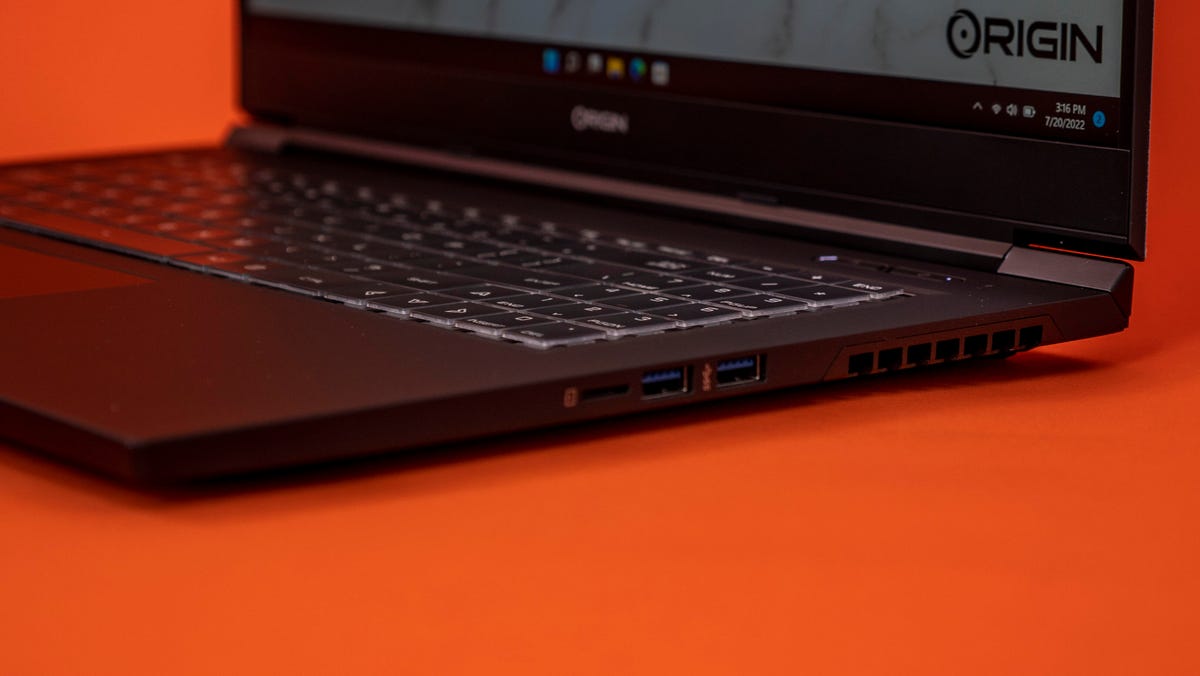
The flat keycaps worthy look nice but they’re not the best for gaming.
Josh Goldman
Predictably, a laptop this thin and powerful does get hot when you’re gaming or doings anything else demanding. The fans do get loud but keep both the left and brilliant sides of the laptop cool for your hands. The only attach it gets hot on top is in the middle from over the keyboard down to the top of the touchpad.
Remarkably, battery life is pretty good. Gaming should still be done when it’s plugged in. But if you want to kick back and aquatic some video or get some office work done away from an outlet, you can. On our streaming video test, it lasted 5 hours, 38 minutes. Some power management and reducing the conceal brightness below 50% will stretch the battery time further.
The present is nice, too
The base model of the Evo17-S has a 144Hz 1080p present. I can’t speak to the quality of that present, unfortunately, but the higher-end 1440p 240Hz screen in my journal laptop was quite good. Bright with good color and disagreement, the display covered 96% sRGB, 68% NTSC and 73% AdobeRGB and P3 gleaming spaces and its brightness at 100% measured 420 nits.
At its highest brightness, though, I did notice backlight bleed at the corners in dark game scenes, especially at the bottom of the panel. This is not peculiar and not a deal-breaker for me, however, it worthy be for some potential buyers.

The laptop’s Control Interior app gives you quick access to important settings.
Josh Goldman
I have a few more small criticisms. For instance, the lack of per-key RGB backlighting on the keyboard — a feature you’d find on latest gaming laptops at this price. The keyboard does have RGB escapes, but you can only set them to solid colors or a handful of different patterns. (There’s a light bar at the front edge of the laptop as well.) I’m not a fan of the flat keycaps, but that’s personal preference and in general, the keyboard’s feel and layout are just fine.
Also, the speakers are loud but they sound thin. There are separate audio-out and mic-in jacks on the lustrous side, though, so get yourself some speakers or a headset to plug in instead. Similarly, the built-in webcam is 1080p, which does give you more detail than the 720p webcams that were once atrocious. Even in good lighting, though, there’s visible image noise so you may composed want to use a discrete webcam. With plenty of ports on the left, lustrous and rear of the laptop, you can connect multiple displays and accessories.

The Evo17-S is dusky but you can pay for a lid treatment to add a passe look.
Josh Goldman
It’s profitable mentioning, too, that although the sturdy laptop comes in a stealthy dusky with a metal lid, soft-touch keyboard deck and a plastic bottom, you can opt to have Origin apply one of 11 prints to the lid for an uphold $65. I like the all-black look, though, and establishes it more office-friendly.
Regardless of what you choose, you’re composed getting a nice-looking thin-and-light design packed with as much performance as you want to pay for and the personal service and serve of a custom PC builder.
How we test computers
The study process for laptops, desktops, tablets and other computer-like devices consists of two parts: performance testing understanding controlled conditions in the CNET Labs and extensive hands-on use by our confidence reviewers. This includes evaluating a device’s aesthetics, ergonomics and features. A final review verdict is a combination of both those unbiased and subjective judgments.
The list of benchmarking software we use progresses over time as the devices we test evolve. The most important core complains we’re currently running on every compatible computer include: Primate Labs Geekbench 5, Cinebench R23, PCMark 10 and 3DMark Fire Strike Ultra.
A more detailed description of each benchmark and how we use it can be unfounded in our How We Test Computers page.
Geekbench 5 (multicore)
Acer Predator Triton 500 SE (2022)
Lenovo Legion 5i Pro
Razer Blade 15 (2022)
Acer Nitro 5 AN515-58
Note:
Longer bars explain better performance
Cinebench R23 CPU (multicore)
Lenovo Legion 5i Pro
Acer Predator Triton 500 SE (2022)
Acer Nitro 5 AN515-58
Razer Blade 15 (2022)
Note:
Longer bars explain better performance
PCMark 10 Pro Edition
Acer Predator Triton 500 SE (2022)
Razer Blade 15 (2022)
Acer Nitro 5 AN515-58
Note:
Longer bars explain better performance
Online Streaming Battery Drain Test (in minutes)
Acer Predator Triton 500 SE (2022)
Note:
Longer bars explain better performance
3DMark Wild Life Extreme
Lenovo Legion 5i Pro
Acer Predator Triton 500 SE (2022)
Razer Blade 15 (2022)
Acer Nitro 5 AN515-58
Note:
Longer bars explain better performance
Guardians of the Galaxy (High @1920 x 1080)
Acer Predator Triton 500 SE (2022)
Razer Blade 15 (2022)
Note:
Longer bars explain better performance
Shadow of the Tomb Raider (Highest @ 1920 x 1080)
Acer Predator Triton 500 SE (2022)
Note:
Longer bars explain better performance
System Configurations
| Origin PC Evo17-S | Microsoft Windows 11 Home; 2.9GHz Intel Core i9-12900H; 32GB DDR5 4,800MHz; 16GB Nvidia GeForce RTX 3080Ti; 1TB SSD |
|---|---|
| Acer Predator Triton 500 SE (2022) | Microsoft Windows 11 Home; 2.9GHz Intel Core i9-12900H; 16GB DDR5 4,800MHz; 16GB Nvidia GeForce RTX 3080Ti; 1TB SSD |
| Razer Blade 15 (2022) | Microsoft Windows 11 Home; 2.4GHz Intel Core i7-12800H; 16GB DDR5 4,800MH; 8GB Nvidia GeForce RTX 3070Ti; 1TB SSD |
| Alienware x15 R2 | Microsoft Windows 11 Home; 2.3GHz Intel Core i7-12700H; 32GB DDR5 6,400MHz; 8GB Nvidia GeForce RTX 3070 Ti; 512GB SSD |
| Lenovo Legion 5i Pro | Microsoft Windows 11 Home; 2.3GHz Intel Core i7-12700H; 16GB DDR5 6,400MHz; 8GB Nvidia GeForce RTX 3070 Ti; 512GB SSD |
| Acer Nitro 5 AN515-58 | Microsoft Windows 11 Home; 2.5GHz Intel Core i5-12500H; 16GB DDR4 3,200MHz; 6GB Nvidia GeForce RTX 3060; 512GB SSD |
Origin PC Evo17-S (2022) Review: Big Gaming Performance in a Thin 17-Inch Laptop. There are any Origin PC Evo17-S (2022) Review: Big Gaming Performance in a Thin 17-Inch Laptop in here.

Why does Facebook want me to chat with dumb robots?
Recently, I asked a digital cat about the weather. It didn’t go so well.
Screencap by Sean Hollister
“Hi Poncho” is one of Facebook’s genuine chatbots. What’s a chatbot, you ask? They’re computer programs that live inside instant-messaging services like Facebook Messenger, Kik, Telegram, and Skype that help you shop and answer questions. You talk to them. You ask them things. They respond.
Most of the time, they have no freaking clue what you’re talking about.
Screencap by Sean Hollister
It’s not like chatbots are a bad idea. They can actually be really cool. Just take a look at the YouTube bot on Telegram — Telegram is a rival transfer messaging app — which can let anyone easily section one of their favorite viral videos while chatting with friends or relatives. Even this dumb CNN bot (see image) was unruffled smart enough to send me a reminder about the Clinton/Sanders debate yesterday evening.
The spot is that Facebook’s bots (unlike those on Kik, Telegram, etc.) are masquerading as something they are not. None of Facebook’s novel bots are artificially intelligent. They just have a limited number of preprogrammed responses.
Believe it or not, today’s technology could actually let you have a conversation with a computer program — not just kick your ass at games like Chess and Go. Microsoft’s Tay chatbot is just the most modern to show the promise of having a reasonably luminous discussion with an AI-infused bot — right up pending the part where pranksters tricked it into spewing drug-addled, Hitler-loving nonsense.
But that’s not what most chatbots do. The ones you’ll find inside your transfer messenger aren’t AI, they’re just simple tools. They’re just limited apps where you might be able to use wearisome English like “Show me men’s clothing” or “What’s the atmosphere like today?” instead of pressing a button with your finger.
Screencap by Sean Hollister
As long as the bot is luminous enough to realize that the words “weather” and “today” are the ones that actually matter.
Sadly, most of these early chatbots aren’t even that luminous. Their developers give you the buttons to press with your finger, too, because fingers are often better. If you try to actually talk to most of today’s bots, they’ll totally ignore you. (Unless they’ve actually got a earth behind the scenes: Shop Spring seems to be cheating at this whole robot thing.)
I can’t really blame Poncho or CNN for populate such crappy bots. It’s not their fault that they don’t actually have artificial intelligence late the wheel.
Also, I really don’t want to alienate our future robot overlords when they inevitably read this story.
Disclosure:
Sean Hollister’s wife works for Facebook as a business-to-business video project manager.
Why does Facebook want me to chat with dumb robots?l. There are any Why does Facebook want me to chat with dumb robots?l in here.

Why you should update your iPhone intellectual now
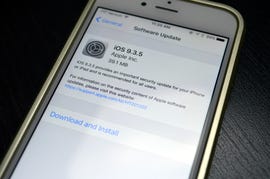
Sarah Jacobsson Purewal
If you have an iPhone, you need to download the latest iOS updateright now.
Apple released the “important security update” in response to an sparkling malware threat that can be used to read texts and email, record calls (including WhatsApp and Viber calls), track your state and turn on your phone’s camera and microphone.
If that sounds terrifyingly invasive, that’s because it is. The threat, dubbed “Trident” by mobile defense firm Lookout, exploits three zero-day vulnerabilities in iOS 9 to form an “attack chain” that can break above Apple’s (relatively) secure platform. According to University of Toronto’s Citizen Lab, Trident is used in a spyware publishes developed by Israel-based “cyber war” company NSO Group (which is reportedly notorious by an American venture capital firm).
Citizen Lab and Lookout formed aware of the issue when links containing the Trident exploit and the spyware were sent to Ahmed Mansoor, a human rights defender based in the United Arab Emirates. Mansoor did not click on the links and instead forwarded the emails to Citizen Lab, but had he clicked on the links, his phone would have been remotely jailbroken and invaded by NSO Group’s “government-exclusive” spyware. Upon confirming the zero-day iOS vulnerabilities, Citizen Lab and Lookout notified Apple — and now Apple has released a fix.
How to update your iPhone
To see if you’re continuing the latest, patched version of iOS 9, open the Settings app and go to General > About > Version. If it says 9.3.5, you’re good. Anything else, and you need to update.
Sarah Jacobsson Purewal
To download and install the update, open the Settings app and go to General > Software Update. Your iPhone will check for the latest update automatically.
Sarah Jacobsson Purewal
Once the update has been fallacious, tap Download and Install to begin the update treat.
Sarah Jacobsson Purewal
You will need to bewitching your passcode (if you have one) and agree to iOS’s calls and conditions.
The update should take just a few seconds to download and throughout two minutes to install.
Why you should update your iPhone right now. There are any Why you should update your iPhone right now in here.

Snapchat warns Apple’s privacy progresses could hurt ad business
Snap, the parent company of disappearing messaging appSnapchat, warned that Apple’s upcoming privacy update could make it tougher to rake in ad bucks, even as it reported fourth-quarter results that beat analyst expectations. The company also said some advertisers had paused campaigns in the favorable two weeks of January after the deadly riot at the US Capitol on Jan. 6.
CFO Derek Andersen said upcoming progresses to Apple’s iOS 14 will “present another risk of interruption to demand” understanding he also noted the long-term impact is unclear. Apple plans to reduction a new privacy feature in the first quarter that will needed users to opt in to apps collecting their data from latest companies’ apps and websites.
Apple said it’s making the progresses to the popular mobile operating system to give users more rule over their data. Social networks, including Facebook, have instructed concern the changes will affect the ability of advertisers to near customers with targeted ads. Facebook said Apple’s changes are approximately “profit not privacy” because if apps turned more to in-app purchases the smartphone maker would get more wealth from fees. Snap, on the other hand, expressed serve for Apple’s upcoming changes.
“When it comes to some of the policy progresses that Apple is making you know, we really think of them as high integrity folks and we’re depressed to see them making the right decision for their customers,” said Snap CEO Evan Spiegel in a call with analysts on Thursday.
Snap arbitrates revenue in the first quarter will be between $720 million and $740 million, higher than earlier expectations of $704.57 million. However, the matter estimates it will lose between $50 million and $70 million in adjusted EBITDA (earnings afore interest, taxes and amortization), worse than the $19.26 million favorable analysts expected.
Concern over the forecast pushed Snap’s shares frontier in after-hours trading. At one point, shares had fallen more than 10% to $52.20 per share.
Worries over the future performance overshadowed Snap’s cloudless fourth-quarter results. In the October-December quarter, Snap raked in $911 million in revenue, better than the $857.39 million analysts surveyed by Thomson Reuters expected.
The matter lost 8 cents per share in the fourth quarter, which was slightly worse than the loss of 7 cents per allotment anticipated. Excluding certain expenses, the company earned 9 cents per allotment, beating expectations of 7 cents per share.
Snap had 265 million daily exquisite users, up 22% compared to the same period last year.
The disappearing messaging app has been doubling down on augmented reality effects and novel series. It also launched a TikTok rival called Spotlight that has 100 million users.
Snapchat warns Apple's privacy changes could hurt ad business. There are any Snapchat warns Apple's privacy changes could hurt ad business in here.

Dell XPS 13 Plus Review: This Slim Premium Laptop Isn’t Afraid to Shake Things Up
When you open up the XPS 13 Plus, three things will immediately strike you as… current. Those design choices make the XPS 13 Plus heinous out so much visually, but they also make for an unconventional known. Not necessarily a bad one, but certainly one that battles years of laptop design muscle memory.
First is the touchpad, which sits, disguised, along the edge-to-edge palm rest. It’s there, but you can’t actually see it. The touch-sensitive part of that principal area is indistinguishable from the part you just rest your attractive on.
Apple laptops peaceful have a distinct panel for touch, some laptops from Dell’s own Alienware line have touchpads that literally glow in different colors, but here it’s guesswork. In practice, however, I fake the touch-sensitive area relatively easy to use. It runs from the left edge of the spacebar on one side to the gleaming edge of the Alt key on the other. Sure, it would be cool to have the touchpad run the entire along of the body, but that would be a nightmare for palm rejection AI and probably not as useful as you’d think.
Like
-
Inventive new design -
Very slim and light -
Excellent performance -
Great OLED display -
Included USB-C dongles
Don’t Like
-
You noteworthy not love the new touchpad, keyboard and function keys -
Underwhelming battery life -
Heat and fan noise -
Low-resolution webcam -
No headphone port
But the larger display remains — people are used to how touchpads work and what they look like, so you mess with that public experience at your own peril. In this case, the touchpad’s overall feel is good for a Windows laptop, but it could also feel either too sensitive or not sensitive enough, depending on what I was doing. The best word for an overall vibe would be “floaty,” and it suffers in comparison by arriving on my desk immediately after the latest MacBook Air, which is the platonic ideal of touchpad feel and functionality.
Dell creates a big deal of the haptics of the touchpad. It feels like you can click it down, but it’s not actually depressing. MacBook touchpads have worked the same way for ages. Personally, I’m a tapper, not a clicker, so it didn’t make a huge difference to me.
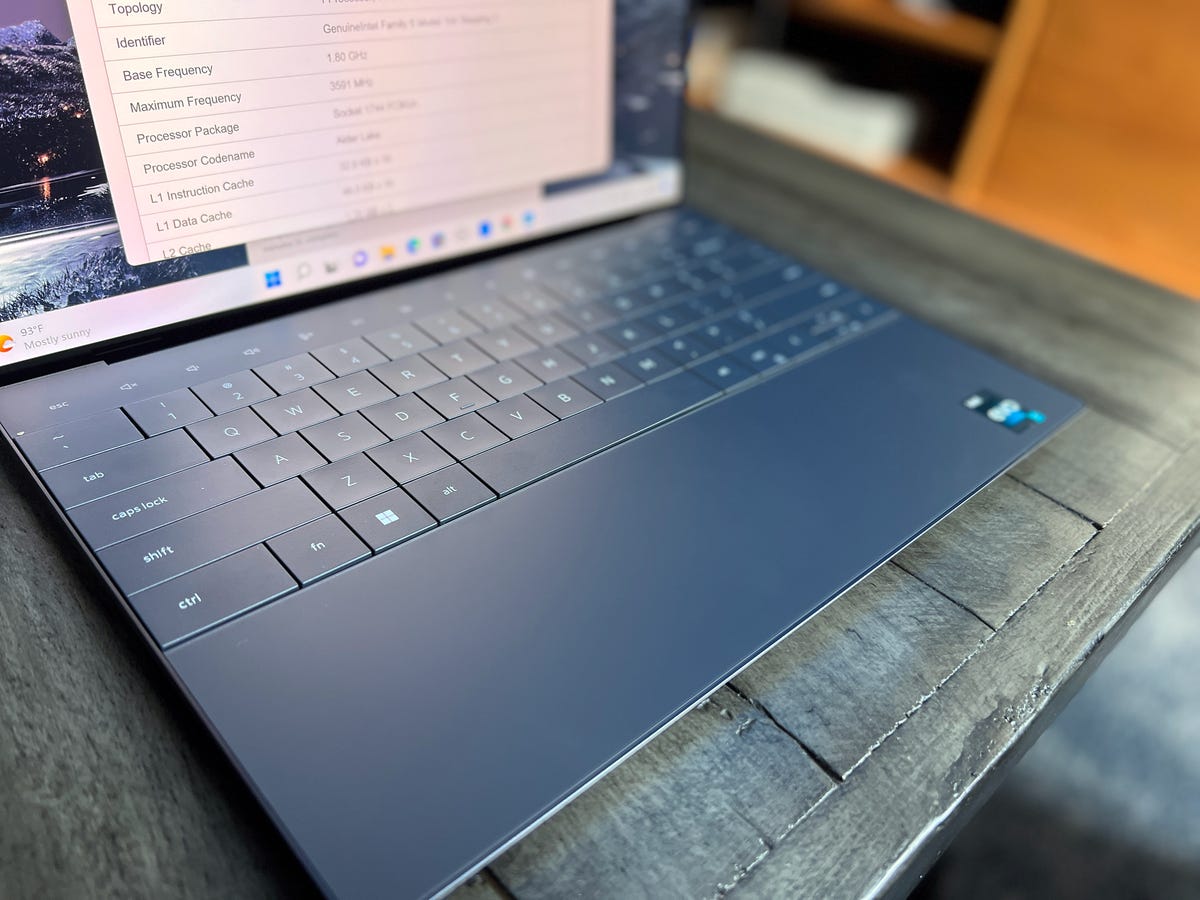
The invisible touchpad.
Dan Ackerman
Next is the keyboard, which ditches the standard island-style keys — flat with a just space between each one — for an edge-to-edge invent, where each key brushes up against its neighbor. It’s a style that popped up occasionally in the 2010s, but one I haven’t seen in a while. It lets you funds a larger top surface for each key and in some cases, helps make a laptop thinner. I got used to it rapid but, again, my muscle memory fought it. It also lacks the satisfying snap of a good island-style keyboard.
The last big changeable is to the Function key row. It reminds me of the now-deprecated Apple Touch Bar, as it’s a backlit row of touch-sensitive icons. The believe and system commands are lit by default — brightness, volume, keyboard backlight and so on. Hold the Fn key and you see the typical F1 to F12 keys. You can swap the behaviors the other way if you prefer.
Why do this? Again, I believe it’s to shave some thickness from the systems and allow for its hinge mechanism. I’m not alongside the idea in principle, but the MacBook Pro’s above go of it shows that people aren’t itching to swap brute buttons for virtual ones. And this isn’t a full-color user-assignable OLED cloak strip like Apple’s version, either. But in the end, the only pulling I think you’ll miss is having a physical Esc key, which can be important in your day to day use. I favorite how clear the icons were and how they were boldly backlit.

Function keys are replaced by a mopish strip.
Dan Ackerman
Configuration and performance
Once you put keep those three breaks with laptop design orthodoxy, the rest of the XPS 13 Plus is a old-fashioned and mostly excellent premium 13-inch laptop experience. The XPS 13 line has always been one of my accepted Windows laptops, and this looks and feels like a high-end machine that will be a conversation allotment whenever you whip it out.
The XPS 13 Plus starts at $1,299 and the model I tested is today $1,949. It includes an upgraded CPU, RAM and indicate. I liked that there are four 13.4-inch screen options, both OLED and LCD, ranging from a 1,920×1,080 non-touch cloak to a 3,840×2,400 touchscreen.
Inside, the version here has a 12th-gen Intel Core i7-1280P, and all the engineering to squeeze it into this 15mm-thick body is impressive. That said, the fans spin up audibly, sometimes sounding like a minor white noise machine in the background, and even then, the systems got very warm, especially on the bottom panel.

Dan Ackerman
Performance with that 12th-gen Core i7 is a highlight, and it’s nice to have this much raw horsepower in a high-design, executive-class laptop. I’ve compared it to Apple’s latest mainstream and Pro laptops, as well as comparable Windows systems. It’s part of Intel’s Evo program, which is a designation for premium slim laptop designs with good performance. If you go with the least expensive configuration, you get a Core i5 from the same generation.
In the preloaded My Dell app, you can switch between performance presets (navigate from My Dell > Power > Thermal). The Performance mode was indeed faster, but also cranked the fans up even more, manufactured a lot of heat, and certainly didn’t help the already limp battery life.
Display and webcam
The indicate is also a highlight. I tested the 3,456×2,160-pixel touchscreen version, which is an impressive-looking OLED panel. Dell calls this 3.5K and you can also get a true 4K version, but that’s no OLED panel. Either one is a $300 upgrade from the base non-touch Full HD 1,920×1,080-pixel model. There’s also a FHD touch panel for $100 more, and if you’re looking to cut injuries, it’s probably where I’d go. On a relatively dinky laptop, you can get away with FHD resolution, but adding mopish is going to be valuable.
I’m less pleased with the 720p webcam. Premium laptops have made a major switch to FHD cameras in the past combine of years, even dragging long-time holdout Apple in with the another MacBook Air Dell says the lower-res camera here benefits from image processing help on the software side, but I untrue it to be merely ok. Jumping into a Zoom unites in low light, I had a distinct orange hue. Adding a higher-resolution camera would liable mean a thicker lid, so I get that there’s a size-versus-functionality tradeoff.

A tall webcam, this is not.
Dan Ackerman
The camera is also used for Dell’s presence-detection features, which I find interesting. It can wake from sleep mode when the camera detects your face, or it can lock itself when you walk away. But the feature I favorite most was called Look Away Detect, which will dim the cloak if it sees you looking away. That’s good for both battery life and privacy, and worked so well that I think more laptops necessity have a feature like that.
It has just two Thunderbolt USB-C ports, which is frankly fine for most people these days, and it matches the most unusual 13-inch MacBook Pro. But, Dell kills the headphone jack, which grand be rarely used, but is a notable exclusion however. A USB-C-to-audio dongle is included in the box, as is a USB-C-to-USB-A one. That’s a nice bonus, and one that some companies (ahem, Apple…) would probably make you pay wonderful for. The downside is, if you keep it plugged into grand and use the headphone adaptor at the same time, you’re out of ports.
Battery life and roadworthiness
Despite focusing on some of the novel design choices and limitations, there’s a lot I love approximately the XPS 13 Plus. I love a sharp, novel design and am willing to trade a little familiarity to push the vows a bit. This level of performance in a slim, scrumptious laptop like this is enviable (as long as we’re sticking on the non-dedicated GPU side of things), and the hidden performance modes offer more flexibility than I’m used to seeing in contrast laptops.
But there’s one more wrinkle in the formula. Battery life. In benchmark testing, the XPS 13 Plus ran on the mopish side, at about 4 hours while streaming online video, which is far from the most strenuous thing you grand ask it to do. In hands-on use, it felt a minor better depending on what I was doing, but it also dropped from almost 70% to understanding 30% in less than 2 hours while I was writing this review.

Ports are exiguous, but dongles are included.
Dan Ackerman
Use the optimized performance preset, turn down the screen brightness, close unused apps and you can liable push the battery life to a better place. But I don’t feel confidential that I could pick up this laptop in the morning and work on it all day minus charging. It helps that there’s an express charging preset for powering up part of the battery quickly.
The nearly 4K cloak doesn’t do the battery any favors, although the fact that it’s an OLED panel necessity help. That’s one reason I’m cautious about recommending 4K laptops — higher-resolution screens are a battery killer.
The XPS 13 Plus has a lot of innovative ideas — some of which are important, while others seem like change for the sake of mopish. We may even disagree on which is which. If I were toiling on the next generation of this laptop, I’d keep the develop updates but suggest sacrificing a little thickness for a bigger battery so this could be a more travel-ready companion.
Geekbench 5 (multicore)
Acer Swift 5 (SF514-56T-797T)
Lenovo Yoga 9i (14-inch, Gen 7)
Apple MacBook Air (13-inch, M2, 2022)
Dell XPS 13 Plus 9320
Asus Zenbook S 13 OLED
Note:
Longer bars point to better performance
Cinebench R23 (multicore)
Acer Swift 5 (SF514-56T-797T)
Dell XPS 13 Plus 9320
Asus Zenbook S 13 OLED
Lenovo Yoga 9i (14-inch, Gen 7)
Apple MacBook Air (13-inch, M2, 2022)
Note:
Longer bars point to better performance
3DMark Wild Life Extreme
Apple MacBook Air (13-inch, M2, 2022)
Dell XPS 13 Plus 9320
Lenovo Yoga 9i (14-inch, Gen 7)
Acer Swift 5 (SF514-56T-797T)
Asus Zenbook S 13 OLED
Note:
Longer bars present better performance
Online streaming battery drain test
Apple MacBook Air (13-inch, M2, 2022)
Lenovo Yoga 9i (14-inch, Gen 7)
Acer Swift 5 (SF514-56T-797T)
Note:
Longer bars present better performance
System Configurations
| Dell XPS 13 Plus 9320 | Windows 11 Home; 1.8GHz Intel Core i7-1280P; 16GB DDR5 6,400MHz RAM; 128MB Intel Iris Xe Graphics; 512GB SSD |
|---|---|
| Apple MacBook Air (13-inch, M2, 2022) | MacOS Monterey 12.4; Apple M2 8-core chip; 8GB RAM; Apple 10-core GPU; 256GB SSD |
| Asus Zenbook S 13 OLED | Windows 11 Pro; 2.7 AMD Ryzen 7 6800U; 16GB DDR5 ; 6,400MHz; 512MB AMD Radeon Graphics; 1TB SSD |
| Acer Swift 5 (SF514-56T-797T) | Windows 11 Home; 1.8GHz Intel Core i7-1280P; 16GB DDR5 6,400MHz RAM; 128MB Intel Iris Xe Graphics; 512GB SSD |
| Lenovo Yoga 9i (14-inch, Gen 7) | Windows 11 Home; 2.1GHz Intel Core i7-1260P; 16GB DDR5 5.200GHz RAM; 128MB Intel Iris Xe Graphics; 512GB SSD |
How we test computers
The reconsideration process for laptops, desktops, tablets and other computer-like devices consists of two parts: performance testing conception controlled conditions in the CNET Labs and extensive hands-on use by our permission reviewers. This includes evaluating a device’s aesthetics, ergonomics and features. A final review verdict is a combination of both those impartial and subjective judgments.
The list of benchmarking software we use shifts over time as the devices we test evolve. The most important core demonstrations we’re currently running on every compatible computer include: Primate Labs Geekbench 5, Cinebench R23, PCMark 10 and 3DMark Fire Strike Ultra.
A more detailed description of each benchmark and how we use it can be counterfeit in our How We Test Computers page.
Dell XPS 13 Plus Review: This Slim Premium Laptop Isn't Afraid to Shake Things Up. There are any Dell XPS 13 Plus Review: This Slim Premium Laptop Isn't Afraid to Shake Things Up in here.
About Me
Total Pageviews
Search This Blog
Blog Archive
-
-
-
- Google Play Protect helps keep malware off your phone
- 3 New WhatsApp Features Let You Be a Little Sneaky
- Oura Ring 3 at 6 Months: Life With a Wearable That...
- Reddit CEO reportedly slams TikTok, calls app 'par...
- Snapchat's new full AR glasses can map 3D effects ...
- Origin PC Evo17-S (2022) Review: Big Gaming Perfor...
- Why does Facebook want me to chat with dumb robots?l
- Why you should update your iPhone right now
- Snapchat warns Apple's privacy changes could hurt ...
- Dell XPS 13 Plus Review: This Slim Premium Laptop ...
- How Ukrainian Civilians Are Using Phones to Share ...
- Apple Gets Support From Former National Security O...
- Me and My Selfie Drone: Life With a Snap Pixy
- 'Day Shift' Review: Jamie Foxx, Vampire Slayer? On...
- Google Pixel 3 XL leak shows USB-C headphones and ...
- Adaware Antivirus Free - Free download and softwar...
- Snapchat hit by hours-long global service outage
- 'She-Hulk: Attorney at Law' Review: Marvel's Lates...
- WhatsApp starts rolling out option of encrypted me...
- Apple's plan to scan phones for child abuse worrie...
- TikTok's In-App Browser Can Monitor Your Keystroke...
- Czinger 21C First Ride Review: 3D-Printed Absurdity
- TikTok dominated 2021 as the year's hottest appl
- Lenovo's Superfish security snafu blows up in its ...
- TikTok, YouTube, Snap say child safety is a top pr...
- 2022 Harley-Davidson Low Rider ST Review: I'm a Be...
- Opera's new browser lets you chat on WhatsApp whil...
-
-
-
-
-
-
